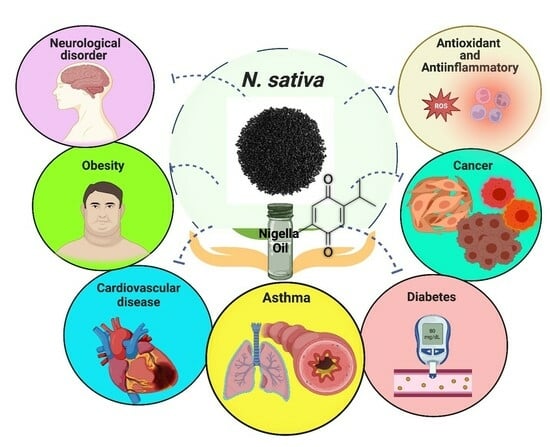Potential Pharmacological Applications of Nigella Seeds with a Focus on Nigella sativa and Its Constituents against Chronic Inflammatory Diseases: Progress and Future Opportunities
Abstract
1. Introduction
2. The Methodology of the Literature Review
3. Global Distribution
3.1. Traditional Uses of Nigella
3.2. Usefulness of NS in Religious and Medical Scripts
4. Nigella sativa, the Plant, and Its Phytoconstituents
5. Pharmacological Activities of Nigella sativa
5.1. Antioxidant and Anti-Inflammatory
5.2. Immunomodulatory Effects of Nigella sativa
5.3. Anticancer Activity
5.4. Antidiabetic Activity
5.5. Cardiovascular Disease (CVD)
5.6. Neurological Disorder
5.7. Obesity
5.8. The Influence of NS on Asthma Control
5.9. Nigella sativa for the Treatment of COVID-19
6. Clinical Trials
7. Toxicological Properties
8. Conclusions and Future Recommendations
Author Contributions
Funding
Acknowledgments
Conflicts of Interest
References
- Alsayari, A.; Wahab, S. Genus Ziziphus for treating Chronic Inflammatory Diseases. Saudi J. Biol. Sci. 2021, 28, 6897–6914. [Google Scholar] [CrossRef] [PubMed]
- Alsayari, A.; Muhsinah, A.B.; Almaghaslah, D.; Annadurai, S.; Wahab, S. Pharmacological Efficacy of Ginseng against Respiratory Tract Infections. Molecules 2021, 26, 4095. [Google Scholar] [CrossRef] [PubMed]
- Petruzzello, M. Black Cumin|Description, Plant, Seeds, Spice, Medicine, Uses, & Facts|Britannica. 2017. Available online: https://www.britannica.com/plant/black-cumin (accessed on 13 October 2023).
- Yimer, E.M.; Tuem, K.B.; Karim, A.; Ur-Rehman, N.; Anwar, F. Nigella sativa L. (Black Cumin): A Promising Natural Remedy for Wide Range of Illnesses. Evid.-Based Complement. Altern. Med. 2019, 2019, 1528635. [Google Scholar] [CrossRef] [PubMed]
- Tavakkoli, A.; Mahdian, V.; Razavi, B.M.; Hosseinzadeh, H. Review on Clinical Trials of Black Seed (Nigella sativa) and Its Active Constituent, Thymoquinone. J. Pharmacopunct. 2017, 20, 179–193. [Google Scholar]
- Forouzanfar, F.; Fazly Bazzaz, B.S.; Hosseinzadeh, H. Black Cumin (Nigella sativa) and Its Constituent (Thymoquinone): A Review on Antimicrobial Effects. Iran. J. Basic Med. Sci. 2014, 17, 929–938. [Google Scholar]
- Ahmad, A.; Husain, A.; Mujeeb, M.; Khan, S.A.; Najmi, A.K.; Siddique, N.A.; Damanhouri, Z.A.; Anwar, F. A Review on Therapeutic Potential of Nigella sativa: A Miracle Herb. Asian Pac. J. Trop. Biomed. 2013, 3, 337–352. [Google Scholar] [CrossRef]
- Sharma, N.; Ahirwar, D.; Jhade, D.; Gupta, S. Medicinal and Phamacological Potential of Nigella sativa: A Review. Ethnobot. Rev. 2009, 13, 11. [Google Scholar]
- Hadi, S.; Daryabeygi-Khotbehsara, R.; Mirmiran, P.; McVicar, J.; Hadi, V.; Soleimani, D.; Askari, G. Effect of Nigella sativa Oil Extract on Cardiometabolic Risk Factors in Type 2 Diabetes: A Randomized, Double-Blind, Placebo-Controlled Clinical Trial. Phyther. Res. 2021, 35, 3747–3755. [Google Scholar] [CrossRef]
- Amizadeh, S.; Rashtchizadeh, N.; Khabbazi, A.; Ghorbanihaghjo, A.; Ebrahimi, A.-A.; Vatankhah, A.-M.; Malek Mahdavi, A.; Taghizadeh, M. Effect of Nigella sativa Oil Extracts on Inflammatory and Oxidative Stress Markers in Behcet’s Disease: A Randomized, Double-Blind, Placebo-Controlled Clinical Trial. Avicenna J. Phytomed. 2020, 10, 181–189. [Google Scholar]
- Corneanu, C.G.; Corneanu, M. Considerations on Human Evolution and on Species Origin Centers. Oltenia Stud. Comunicări Științele Nat. 2011, 27, 210–217. [Google Scholar]
- Saad, B.; Said, O. Greco-Arab and Islamic Herbal Medicine: Traditional System, Ethics, Safety, Efficacy, and Regulatory Issues; Wiley: Hoboken, NJ, USA, 2011; ISBN 9780470474211. [Google Scholar]
- Ved, D.K.; Goraya, G.S. Demand and Supply of Medicinal Plants in India; NMPB: New Delhi India; FRLHT: Bangalore, India, 2007; pp. 1–18. [Google Scholar]
- Rabbani, M.A.; Ghafoor, A.; Masood, M.S. Narc-Kalonji: An Early Maturing and High Yielding Variety of Nigella sativa Released for Cultivation in Pakistan. Pakistan J. Bot. 2011, 43, 191–195. [Google Scholar]
- Koocheki, A.A. Indigenous Knowledge in Agriculture with Particular Reference to Saffron Production in Iran. Acta Hortic. 2004, 650, 175–182. [Google Scholar] [CrossRef]
- Toma, C.C.; Simu, G.M.; Hanganu, D.; Olah, N.; Vata, F.M.G.; Hammami, C.; Hammami, M. Chemical Composition of the Tunisian Nigella sativa. Note II. Profile on Fatty Oil. Farmacia 2013, 61, 454–458. [Google Scholar]
- Botnick, I.; Xue, W.; Bar, E.; Ibdah, M.; Schwartz, A.; Joel, D.M.; Lev, E.; Fait, A.; Lewinsohn, E. Distribution of Primary and Specialized Metabolites in Nigella sativa Seeds, a Spice with Vast Traditional and Historical Uses. Molecules 2012, 17, 10159–10177. [Google Scholar] [CrossRef] [PubMed]
- Burdock, G.A. Assessment of Black Cumin (Nigella sativa L.) as a Food Ingredient and Putative Therapeutic Agent. Regul. Toxicol. Pharmacol. 2022, 128, 105088. [Google Scholar] [CrossRef]
- Hoppe, B. Handbuch des Arznei-und Gewürzpflanzenbaus; Verein für Arznei-und Gewürzpflanzen Saluplanta: Aschersleben, Germany, 2009. [Google Scholar]
- Paarakh, P.M. Nigella sativa Linn.—A Comprehensive Review. Indian J. Nat. Prod. Resour. 2010, 1, 409–429. [Google Scholar]
- Al-Naqe, G.N.; Ismail, M.M.; Al-Zuba, A.S.; Esa, N.M. Nutrients Composition and Minerals Content of Three Different Samples of Nigella sativa L. Cultivated in Yemen. Asian J. Biol. Sci. 2009, 2, 43–48. [Google Scholar] [CrossRef]
- Teuscher, E.; Bauermann, U.; Werner, M.; Brinckmann, J.A.; Lindenmaier, M.P.; Duke, J.A. Book Review: Medicinal Spices: A Handbook of Culinary Herbs, Spices, Spice Mixtures and Their Essential Oils. Food Nutr. Bull. 2006, 27, 271. [Google Scholar] [CrossRef]
- Gashaw, Z. Status of Black Cumin (Nigella sativa L.) Research and Production in Ethiopia; A Review. Int. J. For. Hortic. 2020, 6, 20–29. [Google Scholar] [CrossRef]
- Kifelew, H.; Fikere, D.; Luleseged, T.; Bekele, D.; Mitiku, H. Wakjira Seed Spices Production Guideline; Ethiopian Institute of Agricultural Research: Addis Ababa, Ethiopia, 2017; pp. 1–36. [Google Scholar]
- Assefa, E. Adaptability Study of Black Cumin (Nigella sativa L.) Varieties in the Mid and High Land Areas of Kaffa Zone, South West Ethiopia. Agric. For. Fish. 2015, 4, 14. [Google Scholar] [CrossRef]
- Hammo, Y.H. Effect of Very High Levels of Nitrogen and Phospours Fertilizers, Pinching, and Seed Rate Sowing on Growth, Seed Yield and Componentes of Nigella sativa L. 2—Seed Compenents. Mesopotamia J. Agric. 2008, 36, 2–11. [Google Scholar] [CrossRef][Green Version]
- Heiss, A.G.; Stika, H.-P.; De Zorzi, N.; Jursa, M. Nigella in the Mirror of Time: A Brief Attempt to Draw a Genus’ Ethnohistorical Portrait. Sylt Kastanas Festschrift Helmut Johannes Kroll 2013, 69, 147–169. [Google Scholar] [CrossRef]
- Marshall, H.S.; Thompson, R.C. A Dictionary of Assyrian Botany. Kew Bull. 1951, 6, 27. [Google Scholar] [CrossRef]
- Fadl, M. Comparison between Archaeobotany of Inland and Coastal Sites in the Eastern Desert of Egypt in 300 B.C.–700 A.D. Int. Res. J. Plant Sci. 2013, 4, 117–132. [Google Scholar]
- Van der Veen, M. Formation Processes of Desiccated and Carbonized Plant Remains—The Identification of Routine Practice. J. Archaeol. Sci. 2007, 34, 968–990. [Google Scholar] [CrossRef]
- Osbaldeston, T.A. De Materia Medica—Introduction; Wechelus: Paris, France, 2000. [Google Scholar]
- Srinivasan, K. Cumin (Cuminum cyminum) and Black Cumin (Nigella sativa) Seeds: Traditional Uses, Chemical Constituents, and Nutraceutical Effects. Food Qual. Saf. 2018, 2, 1–16. [Google Scholar] [CrossRef]
- Bühler, A.; Römer, T.; Schmid, K. The Joseph Story between Egypt and Israel; Mohr Siebeck: Tübingen, Germany, 2021. [Google Scholar]
- Al-Bukhari, M.I.; Sahi, A.B. The Collection of Authentic Sayings of Prophet Mohammad (Peace Be upon Him), Division 71 on Medicine; Hilal Yayinlari: Ankara, Turkey, 1976. [Google Scholar]
- Bhatti, I.; Zubair, H.; Bakhsh, M.S.; Akhlaq, M. The Scientific Importance of Nigella sativa (Kalonji) and Honey in Accordance with Tib-E-Nabvi. Gomal Univ. J. Res. 2013, 29, 27–30. [Google Scholar]
- Heiss, A.G.; Oeggl, K. The Oldest Evidence of Nigella Damascena L. (Ranunculaceae) and Its Possible Introduction to Central Europe. Veg. Hist. Archaeobot. 2005, 14, 562–570. [Google Scholar] [CrossRef]
- Geraci, A.; Polizzano, V.; Schicchi, R. Ethnobotanical Uses of Wild Taxa as Galactagogues in Sicily (Italy). Acta Soc. Bot. Pol. 2018, 87, 1–18. [Google Scholar] [CrossRef]
- Jarić, S.; Mitrović, M.; Karadžić, B.; Kostić, O.; Djurjević, L.; Pavlović, M.; Pavlović, P. Plant Resources Used in Serbian Medieval Medicine. Ethnobotany and Ethnomedicine. Genet. Resour. Crop Evol. 2014, 61, 1359–1379. [Google Scholar] [CrossRef]
- Leporatti, M.L.; Ghedira, K. Comparative Analysis of Medicinal Plants Used in Traditional Medicine in Italy and Tunisia. J. Ethnobiol. Ethnomed. 2009, 5, 31. [Google Scholar] [CrossRef]
- Abdelmajid, K.; Mohamed, L.; Sidi, A.E.; Ben, M. Plant Resources Use in the Province of Taza (North of Morocco) Evaluation and Sustainable Exploitation of Local Endemic Phytogenetic Resources View Project Medicinal Plants View Project. ProEnvironment Promediu 2011, 4, 347–356. [Google Scholar]
- Bahmani, M.; Eftekhari, Z.; Jelodari, M.; Saki, K.; Abdollahi, R.; Majlesi, M.; Rafieian-Kopaei, M.; Rasouli, S. Effect of Iranian Herbal Medicines in Dysmenorrhea Phytotherapy. J. Chem. Pharm. Res. 2015, 7, 519–526. [Google Scholar]
- Ali-Shtayeh, M.S.; Jamous, R.M.; Jamous, R.M. Plants Used during Pregnancy, Childbirth, Postpartum and Infant Healthcare in Palestine. Complement. Ther. Clin. Pract. 2015, 21, 84–93. [Google Scholar] [CrossRef]
- Khajoei Nasab, F.; Khosravi, A.R. Ethnobotanical Study of Medicinal Plants of Sirjan in Kerman Province, Iran. J. Ethnopharmacol. 2014, 154, 190–197. [Google Scholar] [CrossRef] [PubMed]
- Kartal, Ç.; Güneş, F. Medicinal Plants Used in Meriç Town from Turkey. Indian J. Pharm. Educ. Res. 2017, 51, S249–S253. [Google Scholar] [CrossRef]
- Jaradat, N.A.; Al-Ramahi, R.; Zaid, A.N.; Ayesh, O.I.; Eid, A.M. Ethnopharmacological Survey of Herbal Remedies Used for Treatment of Various Types of Cancer and Their Methods of Preparations in the West Bank-Palestine. BMC Complement. Altern. Med. 2016, 16, 93. [Google Scholar] [CrossRef]
- Pavela, R.; Chermenskaya, T. Potential Insecticidal Activity of Extracts from 18 Species of Medicinal Plants on Larvae of Spodoptera Littoralis—Short Communication. Plant Prot. Sci. 2004, 40, 145–150. [Google Scholar] [CrossRef]
- Sharif, H.R.; Abbas, S.; Majeed, H.; Safdar, W.; Shamoon, M.; Khan, M.A.; Shoaib, M.; Raza, H.; Haider, J. Formulation, Characterization and Antimicrobial Properties of Black Cumin Essential Oil Nanoemulsions Stabilized by OSA Starch. J. Food Sci. Technol. 2017, 54, 3358–3365. [Google Scholar] [CrossRef]
- Shehata, T.M.; Almostafa, M.M.; Elsewedy, H.S. Development and Optimization of Nigella sativa Nanoemulsion Loaded with Pioglitazone for Hypoglycemic Effect. Polymers 2022, 14, 3021. [Google Scholar] [CrossRef]
- Hossain, M.S.; Urbi, Z.; Evamoni, F.Z.; Zohora, F.T.; Rahman, K.M.H. A Secondary Research on Medicinal Plants Mentioned in the Holy Qur’an. J. Med. Plants 2016, 15, 81–97. [Google Scholar]
- Urbi, Z.; Hossain, S.; Hafizur Rahman, K.M.; Zayed, T.M. Grape: A Medicinal Fruit Species in the Holy Qur’an and Its Ethnomedinical Importance. World Appl. Sci. J. 2014, 30, 253–265. [Google Scholar] [CrossRef]
- Alade, G.O.; Ajibesin, K.K. Herbal Medicine: Clerics’ Knowledge in a Sub Urban Center in Niger Delta, Nigeria—A Pilot Study. J. Pharm. Pharmacogn. Res. 2017, 5, 200–216. [Google Scholar]
- Tariq, M. Nigella sativa Seeds: Folklore Treatment in Modern Day Medicine. Saudi J. Gastroenterol. 2008, 14, 105–106. [Google Scholar] [CrossRef]
- Ali, S.A.; Parveen, N.; Ali, A.S. Links between the Prophet Muhammad (PBUH) Recommended Foods and Disease Management: A Review in the Light of Modern Superfoods. Int. J. Health Sci. 2018, 12, 61–69. [Google Scholar]
- Shabana, A.; El-Menyar, A.; Asim, M.; Al-Azzeh, H.; Al Thani, H. Cardiovascular Benefits of Black Cumin (Nigella sativa). Cardiovasc. Toxicol. 2013, 13, 9–21. [Google Scholar] [CrossRef]
- Yuan, H.; Ma, Q.; Ye, L.; Piao, G. The Traditional Medicine and Modern Medicine from Natural Products. Molecules 2016, 21, 559. [Google Scholar] [CrossRef] [PubMed]
- Cheikh-Rouhou, S.; Besbes, S.; Hentati, B.; Blecker, C.; Deroanne, C.; Attia, H. Nigella sativa L.: Chemical Composition and Physicochemical Characteristics of Lipid Fraction. Food Chem. 2007, 101, 673–681. [Google Scholar] [CrossRef]
- Nickavar, B.; Mojab, F.; Javidnia, K.; Roodgar Amoli, M.A. Chemical Composition of the Fixed and Volatile Oils of Nigella sativa L. from Iran. Zeitschrift Naturforsch.-Sect. C J. Biosci. 2003, 58, 629–631. [Google Scholar] [CrossRef]
- Venkatachallam, S.K.T.; Pattekhan, H.; Divakar, S.; Kadimi, U.S. Chemical Composition of Nigella sativa L. Seed Extracts Obtained by Supercritical Carbon Dioxide. J. Food Sci. Technol. 2010, 47, 598–605. [Google Scholar] [CrossRef]
- Jrah Harzallah, H.; Kouidhi, B.; Flamini, G.; Bakhrouf, A.; Mahjoub, T. Chemical Composition, Antimicrobial Potential against Cariogenic Bacteria and Cytotoxic Activity of Tunisian Nigella sativa Essential Oil and Thymoquinone. Food Chem. 2011, 129, 1469–1474. [Google Scholar] [CrossRef]
- Ghedira, K. La Nigelle Cultivée: Nigella sativa L. (Ranunculaceae). Phytotherapie 2006, 4, 220–226. [Google Scholar] [CrossRef]
- Houghton, P.J.; Zarka, R.; De Las Heras, B.; Hoult, J.R.S. Fixed Oil of Nigella sativa and Derived Thymoquinone Inhibit Eicosanoid Generation in Leukocytes and Membrane Lipid Peroxidation. Planta Med. 1995, 61, 33–36. [Google Scholar] [CrossRef] [PubMed]
- El–Dakhakhny, M. Studies on the Chemical Constitution of Egyptian Nigella sativa L. Seeds. II 1) the Essential Oil. Planta Med. 1963, 11, 465–470. [Google Scholar] [CrossRef]
- Nathan, C.; Ding, A. Nonresolving Inflammation. Cell 2010, 140, 871–882. [Google Scholar] [CrossRef]
- Burits, M.; Asres, K.; Bucar, F. The Antioxidant Activity of the Essential Oils of Artemisia Afra, Artemisia Abyssinica and Juniperus Procera. Phyther. Res. 2001, 15, 103–108. [Google Scholar] [CrossRef] [PubMed]
- Begum, S.; Mannan, A. A Review on Nigella sativa: A Marvel Herb. J. Drug Deliv. Ther. 2020, 10, 213–219. [Google Scholar] [CrossRef]
- Keyhanmanesh, R.; Bagban, H.; Nazemiyeh, H.; Bavil, F.M.; Alipour, M.R.; Ahmady, M. The Relaxant Effects of Different Methanolic Fractions of Nigella sativa on Guinea Pig Tracheal Chains. Iran. J. Basic Med. Sci. 2013, 16, 123–128. [Google Scholar]
- Bordoni, L.; Fedeli, D.; Nasuti, C.; Maggi, F.; Papa, F.; Wabitsch, M.; De Caterina, R.; Gabbianelli, R. Antioxidant and Anti-Inflammatory Properties of Nigella sativa Oil in Human Pre-Adipocytes. Antioxidants 2019, 8, 51. [Google Scholar] [CrossRef] [PubMed]
- Salem, M.L. Immunomodulatory and Therapeutic Properties of the Nigella sativa L. Seed. Int. Immunopharmacol. 2005, 5, 1749–1770. [Google Scholar] [CrossRef]
- Khaldi, T.; Chekchaki, N.; Boumendjel, M.; Taibi, F.; Abdellaoui, M.; Messarah, M.; Boumendjel, A. Ameliorating Effects of Nigella sativa Oil on Aggravation of Inflammation, Oxidative Stress and Cytotoxicity Induced by Smokeless Tobacco Extract in an Allergic Asthma Model in Wistar Rats. Allergol. Immunopathol. 2018, 46, 472–481. [Google Scholar] [CrossRef] [PubMed]
- Tuna, H.I.; Babadag, B.; Ozkaraman, A.; Balci Alparslan, G. Investigation of the Effect of Black Cumin Oil on Pain in Osteoarthritis Geriatric Individuals. Complement. Ther. Clin. Pract. 2018, 31, 290–294. [Google Scholar] [CrossRef] [PubMed]
- Ahmed, J.H.; Kadhim, S.N.; Al-Hamdi, K.I. The Effectiveness of Nigella sativa, Methotrexate and Their Combination in the Treatment of Moderate to Severe Psoriasis. J. Clin. Exp. Investig. 2015, 5, 521–528. [Google Scholar] [CrossRef]
- Badri, W.; El Asbahani, A.; Miladi, K.; Baraket, A.; Agusti, G.; Nazari, Q.A.; Errachid, A.; Fessi, H.; Elaissari, A. Poly (ε-Caprolactone) Nanoparticles Loaded with Indomethacin and Nigella sativa L. Essential Oil for the Topical Treatment of Inflammation. J. Drug Deliv. Sci. Technol. 2018, 46, 234–242. [Google Scholar] [CrossRef]
- Rizvi, A.; Mahdi, A.A.; Wahab, S.; Mishra, A. Protective Effects of Butea frondosa Leaves against Stress Induced Immune Impairment in Sprague Dawley Rats. Pak. J. Pharm. Sci. 2018, 31, 2457–2462. [Google Scholar] [PubMed]
- Bascones-Martinez, A.; Mattila, R.; Gomez-Font, R.; Meurman, J.H. Immunomodulatory Drugs: Oral and Systemic Adverse Effects. Med. Oral Patol. Oral Cir. Bucal 2014, 19, e24–e31. [Google Scholar] [CrossRef]
- Haq, A.; Abdullatif, M.; Lobo, P.I.; Khabar, K.S.A.; Sheth, K.V.; Al-Sedairy, S.T. Nigella sativa: Effect on Human Lymphocytes and Polymorphonuclear Leukocyte Phagocytic Activity. Immunopharmacology 1995, 30, 147–155. [Google Scholar] [CrossRef]
- Taifa, S.; Muhee, A.; Bhat, R.A.; Nabi, S.U.I.; Roy, A.; Rather, G.A.; Khan, A.A.; Bashir, S.M.; Patwekar, M.; Wahab, S.; et al. Evaluation of Therapeutic Efficacy of Copper Nanoparticles in Staphylococcus Aureus—Induced Rat Mastitis Model. J. Nanomater. 2022, 2022, 7124114. [Google Scholar] [CrossRef]
- Islam, S.N.; Begum, P.; Ahsan, T.; Huque, S.; Ahsan, M. Immunosuppressive and Cytotoxic Properties of Nigella sativa. Phyther. Res. 2004, 18, 395–398. [Google Scholar] [CrossRef]
- Swamy, S.M.K.; Tan, B.K.H. Cytotoxic and Immunopotentiating Effects of Ethanolic Extract of Nigella sativa L. Seeds. J. Ethnopharmacol. 2000, 70, 1–7. [Google Scholar] [CrossRef] [PubMed]
- Twilley, D.; Rademan, S.; Lall, N. A Review on Traditionally Used South African Medicinal Plants, Their Secondary Metabolites and Their Potential Development into Anticancer Agents. J. Ethnopharmacol. 2020, 261, 113101. [Google Scholar] [CrossRef] [PubMed]
- Wahab, S.; Ahmad, I.; Irfan, S.; Baig, M.H.; Farouk, A.-E.; Dong, J.-J. Use of Natural Compounds as a Potential Therapeutic Agent Against COVID-19. Curr. Pharm. Des. 2021, 27, 1144–1152. [Google Scholar] [CrossRef]
- Alshehri, S.A.; Wahab, S.; Abullais, S.S.; Das, G.; Hani, U.; Ahmad, W.; Amir, M.; Ahmad, A.; Kandasamy, G.; Vasudevan, R. Pharmacological Efficacy of Tamarix Aphylla: A Comprehensive Review. Plants 2022, 11, 118. [Google Scholar] [CrossRef] [PubMed]
- Wahab, S.; Hussain, A. Cytokines as Targets for Immunomodulation. Int. J. Pharm. Pharm. Sci. 2013, 5, 60–64. [Google Scholar]
- Dhanasekaran, S. Phytochemical Characteristics of Aerial Part of Cissus quadrangularis (L) and Its in-Vitro Inhibitory Activity against Leukemic Cells and Antioxidant Properties. Saudi J. Biol. Sci. 2020, 27, 1302–1309. [Google Scholar] [CrossRef]
- Jadhav, V.; Bhagare, A.; Wahab, S.; Lokhande, D.; Vaidya, C.; Dhayagude, A.; Khalid, M.; Aher, J.; Mezni, A.; Dutta, M. Green Synthesized Calcium Oxide Nanoparticles (CaO NPs) Using Leaves Aqueous Extract of Moringa Oleifera and Evaluation of Their Antibacterial Activities. J. Nanomater. 2022, 2022, 9047507. [Google Scholar] [CrossRef]
- Hani, U.; Osmani, R.A.M.; Yasmin, S.; Gowda, B.H.J.; Ather, H.; Ansari, M.Y.; Siddiqua, A.; Ghazwani, M.; Fatease, A.A.; Alamri, A.H.; et al. Novel Drug Delivery Systems as an Emerging Platform for Stomach Cancer Therapy. Pharmaceutics 2022, 14, 1576. [Google Scholar] [CrossRef]
- Shoaib, A.; Tabish, M.; Ali, S.; Arafah, A.; Wahab, S.; Almarshad, F.M.; Rashid, S.; Rehman, M.U. Dietary Phytochemicals in Cancer Signalling Pathways: Role of MiRNA Targeting. Curr. Med. Chem. 2021, 28, 8036–8067. [Google Scholar] [CrossRef]
- Akhtar, M.F.; Saleem, A.; Rasul, A.; Faran Ashraf Baig, M.M.; Bin-Jumah, M.; Abdel Daim, M.M. Anticancer Natural Medicines: An Overview of Cell Signaling and Other Targets of Anticancer Phytochemicals. Eur. J. Pharmacol. 2020, 888, 173488. [Google Scholar] [CrossRef]
- Palanisamy, N.; Manian, S. Protective Effects of Asparagusracemosus on Oxidative Damage in Isoniazid-Induced Hepatotoxic Rats: An in Vivo Study. Toxicol. Ind. Health 2012, 28, 238–244. [Google Scholar] [CrossRef]
- Ahmad, I.; Irfan, S.; Abohashrh, M.; Wahab, S.; Abullais, S.S.; Javali, M.A.; Nisar, N.; Alam, M.M.; Srivastava, S.; Saleem, M.; et al. Inhibitory Effect of Nepeta Deflersiana on Climax Bacterial Community Isolated from the Oral Plaque of Patients with Periodontal Disease. Molecules 2021, 26, 202. [Google Scholar] [CrossRef]
- Khalid, M.; Alqarni, M.H.; Alsayari, A.; Foudah, A.I.; Aljarba, T.M.; Mukim, M.; Alamri, M.A.; Abullais, S.S.; Wahab, S. Anti-Diabetic Activity of Bioactive Compound Extracted from Spondias Mangifera Fruit: In-Vitro and Molecular Docking Approaches. Plants 2022, 11, 562. [Google Scholar] [CrossRef] [PubMed]
- Juárez, P. Plant-Derived Anticancer Agents: A Promising Treatment for Bone Metastasis. Bonekey Rep. 2014, 3, 599. [Google Scholar] [CrossRef] [PubMed]
- Ghosheh, O.A.; Houdi, A.A.; Crooks, P.A. High Performance Liquid Chromatographic Analysis of the Pharmacologically Active Quinones and Related Compounds in the Oil of the Black Seed (Nigella sativa L.). J. Pharm. Biomed. Anal. 1999, 19, 757–762. [Google Scholar] [CrossRef]
- Ali, B.H.; Blunden, G. Pharmacological and Toxicological Properties of Nigella sativa. Phyther. Res. 2003, 17, 299–305. [Google Scholar] [CrossRef]
- Mehraj, T.; Elkanayati, R.M.; Farooq, I.; Mir, T.M. A Review of Nigella sativa and Its Active Principles as Anticancer Agents. In Black Seeds (Nigella sativa); Elsevier: Amsterdam, The Netherlands, 2022; pp. 91–118. [Google Scholar]
- Jia, S.S.; Xi, G.P.; Zhang, M.; Chen, Y.B.; Lei, B.; Dong, X.S.; Yang, Y.M. Induction of Apoptosis by D-Limonene Is Mediated by Inactivation of Akt in LS174T Human Colon Cancer Cells. Oncol. Rep. 2013, 29, 349–354. [Google Scholar] [CrossRef]
- Swamy, S.M.K.; Huat, B.T.K. Intracellular Glutathione Depletion and Reactive Oxygen Species Generation Are Important in α-Hederin-Induced Apoptosis of P388 Cells. Mol. Cell. Biochem. 2003, 245, 127–139. [Google Scholar]
- Effenberger, K.; Breyer, S.; Schobert, R. Terpene Conjugates of the Nigella sativa Seed-Oil Constituent Thymoquinone with Enhanced Efficacy in Cancer Cells. Chem. Biodivers. 2010, 7, 129–139. [Google Scholar] [CrossRef]
- Farah, I.O.; Begum, R.A. Effect of Nigella sativa (N. sativa L.) and Oxidative Stress on the Survival Pattern of MCF-7 Breast Cancer Cells. Biomed. Sci. Instrum. 2003, 39, 359–364. [Google Scholar]
- Gali-Muhtasib, H.; Diab-Assaf, M.; Boltze, C.; Al-Hmaira, J.; Hartig, R.; Roessner, A.; Schneider-Stock, R. Thymoquinone Extracted from Black Seed Triggers Apoptotic Cell Death in Human Colorectal Cancer Cells via a P53-Dependent Mechanism. Int. J. Oncol. 2004, 25, 857–866. [Google Scholar] [PubMed]
- Salim, E.I.; Fukushima, S. Chemopreventive Potential of Volatile Oil from Black Cumin (Nigella sativa L.) Seeds against Rat Colon Carcinogenesis. Nutr. Cancer 2003, 45, 195–202. [Google Scholar] [CrossRef] [PubMed]
- Rooney, S.; Ryan, M.F. Modes of Action of Alpha-Hederin and Thymoquinone, Active Constituents of Nigella sativa, against HEp-2 Cancer Cells. Anticancer Res. 2005, 25, 4255–4259. [Google Scholar] [PubMed]
- Chehl, N.; Chipitsyna, G.; Gong, Q.; Yeo, C.J.; Arafat, H.A. Anti-Inflammatory Effects of the Nigella sativa Seed Extract, Thymoquinone, in Pancreatic Cancer Cells. HPB 2009, 11, 373–381. [Google Scholar] [CrossRef]
- Association, A.D. Diagnosis and Classification of Diabetes Mellitus. Diabetes Care 2009, 32, S62–S67. [Google Scholar] [CrossRef] [PubMed]
- Kifle, Z.D.; Abdelwuhab, M.; Melak, A.D.; Genet, G.; Meseret, T.; Adugna, M. Pharmacological Evaluation of Medicinal Plants with Antidiabetic Activities in Ethiopia: A Review. Metab. Open 2022, 13, 100174. [Google Scholar] [CrossRef]
- Patel, D.K.; Kumar, R.; Laloo, D.; Hemalatha, S. Diabetes Mellitus: An Overview on Its Pharmacological Aspects and Reported Medicinal Plants Having Antidiabetic Activity. Asian Pac. J. Trop. Biomed. 2012, 2, 411–420. [Google Scholar] [CrossRef]
- Kumar, J.A.; Tiwari, A.K.; Ali, A.Z.; Madhusudhana, K.; Reddy, B.S.; Ramakrishna, S.; China Raju, B. New Antihyperglycemic, α-Glucosidase Inhibitory, and Cytotoxic Derivatives of Benzimidazoles. J. Enzyme Inhib. Med. Chem. 2010, 25, 80–86. [Google Scholar] [CrossRef] [PubMed]
- Ahmad, W.; Amir, M.; Ahmad, A.; Ali, A.; Ali, A.; Wahab, S.; Barkat, H.A.; Ansari, M.A.; Sarafroz, M.; Ahmad, A.; et al. Aegle Marmelos Leaf Extract Phytochemical Analysis, Cytotoxicity, in Vitro Antioxidant and Antidiabetic Activities. Plants 2021, 10, 2573. [Google Scholar] [CrossRef] [PubMed]
- Derosa, G.; Maffioli, P. α-Glucosidase Inhibitors and Their Use in Clinical Practice. Arch. Med. Sci. 2012, 8, 899–906. [Google Scholar] [CrossRef]
- Asghari, B.; Salehi, P.; Farimani, M.M.; Ebrahimi, S.N. α-Glucosidase Inhibitors from Fruits of Rosa canina L. Rec. Nat. Prod. 2015, 9, 276–283. [Google Scholar]
- Mohebbati, R.; Abbasnezhad, A. Effects of Nigella sativa on Endothelial Dysfunction in Diabetes Mellitus: A Review. J. Ethnopharmacol. 2020, 252, 112585. [Google Scholar] [CrossRef]
- Hamdan, A.; Idrus, R.H.; Mokhtar, M.H. Effects of Nigella sativa on Type-2 Diabetes Mellitus: A Systematic Review. Int. J. Environ. Res. Public Health 2019, 16, 4911. [Google Scholar] [CrossRef] [PubMed]
- Khader, M.; Eckl, P.M. Thymoquinone: An Emerging Natural Drug with a Wide Range of Medical Applications. Iran. J. Basic Med. Sci. 2014, 17, 950–957. [Google Scholar] [PubMed]
- Abdelrazek, H.M.A.; Kilany, O.E.; Muhammad, M.A.A.; Tag, H.M.; Abdelazim, A.M. Black Seed Thymoquinone Improved Insulin Secretion, Hepatic Glycogen Storage, and Oxidative Stress in Streptozotocin-Induced Diabetic Male Wistar Rats. Oxid. Med. Cell. Longev. 2018, 2018, 8104165. [Google Scholar] [CrossRef] [PubMed]
- Ahmad, S.; Beg, Z.H. Elucidation of Mechanisms of Actions of Thymoquinone-Enriched Methanolic and Volatile Oil Extracts from Nigella sativa against Cardiovascular Risk Parameters in Experimental Hyperlipidemia. Lipids Health Dis. 2013, 12, 86. [Google Scholar] [CrossRef] [PubMed]
- Chen, L.H. Nutritional Aspects of Aging; CRC Press: Boca Raton, FL, USA, 2018; Volume 1, ISBN 9781351083584. [Google Scholar]
- Stehbens, W.E. An Appraisal of Cholesterol Feeding in Experimental Atherogenesis. Prog. Cardiovasc. Dis. 1986, 29, 107–128. [Google Scholar] [CrossRef]
- Farkhondeh, T.; Samarghandian, S.; Azimin-Nezhad, M.; Samini, F. Effect of Chrysin on Nociception in Formalin Test and Serum Levels of Noradrenalin and Corticosterone in Rats. Int. J. Clin. Exp. Med. 2015, 8, 2465–2470. [Google Scholar] [PubMed]
- Samarghandian, S.; Azimi-Nezhad, M.; Borji, A.; Farkhondeh, T. Effect of Crocin on Aged Rat Kidney through Inhibition of Oxidative Stress and Proinflammatory State. Phyther. Res. 2016, 30, 1345–1353. [Google Scholar] [CrossRef]
- Samarghandian, S.; Azimini-Nezhad, M.; Farkhondeh, T. The Effects of Zataria Multiflora on Blood Glucose, Lipid Profile and Oxidative Stress Parameters in Adult Mice During Exposure to Bisphenol A. Cardiovasc. Hematol. Disord. Targets 2016, 16, 41–46. [Google Scholar] [CrossRef]
- Shafiq, H.; Ahmad, A.; Masud, T.; Kaleem, M. Cardio-Protective and Anti-Cancer Therapeutic Potential of Nigella sativa. Iran. J. Basic Med. Sci. 2014, 17, 967–980. [Google Scholar]
- Mansour, M.A.; Nagi, M.N.; El-Khatib, A.S.; Al-Bekairi, A.M. Effects of Thymoquinone on Antioxidant Enzyme Activities, Lipid Peroxidation and Dt-Diaphorase in Different Tissues of Mice: A Possible Mechanism of Action. Cell Biochem. Funct. 2002, 20, 143–151. [Google Scholar] [CrossRef] [PubMed]
- Nagi, M.N.; Mansour, M.A. Protective Effect of Thymoquinone against Doxorubicin-Induced Cardiotoxicity in Rats: A Possible Mechanism of Protection. Pharmacol. Res. 2000, 41, 283–289. [Google Scholar] [CrossRef]
- Khalife, K.H.; Lupidi, G. Reduction of Hypervalent States of Myoglobin and Hemoglobin to Their Ferrous Forms by Thymoquinone: The Role of GSH, NADH and NADPH. Biochim. Biophys. Acta-Gen. Subj. 2008, 1780, 627–637. [Google Scholar] [CrossRef]
- Liu, H.; Liu, H.Y.; Jiang, Y.N.; Li, N. Protective Effect of Thymoquinone Improves Cardiovascular Function, and Attenuates Oxidative Stress, Inflammation and Apoptosis by Mediating the PI3K/Akt Pathway in Diabetic Rats. Mol. Med. Rep. 2016, 13, 2836–2842. [Google Scholar] [CrossRef]
- Ramadan, M.F. Nutritional Value, Functional Properties and Nutraceutical Applications of Black Cumin (Nigella sativa L.): An Overview. Int. J. Food Sci. Technol. 2007, 42, 1208–1218. [Google Scholar] [CrossRef]
- Beheshti, F.; Hosseini, M.; Vafaee, F.; Shafei, M.N.; Soukhtanloo, M. Feeding of Nigella sativa during Neonatal and Juvenile Growth Improves Learning and Memory of Rats. J. Tradit. Complement. Med. 2016, 6, 146–152. [Google Scholar] [CrossRef]
- Cascella, M.; Bimonte, S.; Barbieri, A.; Del Vecchio, V.; Muzio, M.R.; Vitale, A.; Benincasa, G.; Ferriello, A.B.; Azzariti, A.; Arra, C.; et al. Dissecting the Potential Roles of Nigella sativa and Its Constituent Thymoquinone on the Prevention and on the Progression of Alzheimer’s Disease. Front. Aging Neurosci. 2018, 10, 1208–1218. [Google Scholar] [CrossRef] [PubMed]
- Khan, M.I.; Ahmad, M.F.; Ahmad, I.; Ashfaq, F.; Wahab, S.; Alsayegh, A.A.; Kumar, S.; Hakeem, K.R. Arsenic Exposure through Dietary Intake and Associated Health Hazards in the Middle East. Nutrients 2022, 14, 2136. [Google Scholar] [CrossRef]
- Zhang, Y.; Chen, H.; Li, R.; Sterling, K.; Song, W. Amyloid β-Based Therapy for Alzheimer’s Disease: Challenges, Successes and Future. Signal Transduct. Target. Ther. 2023, 8, 248. [Google Scholar] [CrossRef]
- Selkoe, D.J. Alzheimer’s Disease: Genes, Proteins, and Therapy. Physiol. Rev. 2001, 81, 741–766. [Google Scholar] [CrossRef]
- Elibol, B.; Beker, M.; Terzioglu-Usak, S.; Dalli, T.; Kilic, U. Thymoquinone Administration Ameliorates Alzheimer’s Disease-like Phenotype by Promoting Cell Survival in the Hippocampus of Amyloid Beta1–42 Infused Rat Model. Phytomedicine 2020, 79, 153324. [Google Scholar] [CrossRef] [PubMed]
- Cobourne-Duval, M.K.; Taka, E.; Mendonca, P.; Soliman, K.F.A. Thymoquinone Increases the Expression of Neuroprotective Proteins While Decreasing the Expression of Pro-Inflammatory Cytokines and the Gene Expression NFκB Pathway Signaling Targets in LPS/IFNγ -Activated BV-2 Microglia Cells. J. Neuroimmunol. 2018, 320, 87–97. [Google Scholar] [CrossRef] [PubMed]
- Alhibshi, A.H.; Odawara, A.; Suzuki, I. Neuroprotective Efficacy of Thymoquinone against Amyloid Beta-Induced Neurotoxicity in Human Induced Pluripotent Stem Cell-Derived Cholinergic Neurons. Biochem. Biophys. Rep. 2019, 17, 122–126. [Google Scholar] [CrossRef] [PubMed]
- Poorgholam, P.; Yaghmaei, P.; Hajebrahimi, Z. Thymoquinone Recovers Learning Function in a Rat Model of Alzheimer’s Disease. Avicenna J. Phytomed. 2018, 8, 188–197. [Google Scholar] [PubMed]
- El-Naggar, T.; Gómez-Serranillos, M.P.; Palomino, O.M.; Arce, C.; Carretero, M.E. Nigella sativa L. Seed Extract Modulates the Neurotransmitter Amino Acids Release in Cultured Neurons in Vitro. J. Biomed. Biotechnol. 2010, 2010, 398312. [Google Scholar] [CrossRef]
- Sandhua, K.S.; Cranab, A. Evaluation of Anti Parkinson’S Activity of Nigella sativa (Kalonji) Seeds in Chlorpromazineinduced Experimental Animal Model. Int. J. Pharm. Pharm. Sci. 2013, 5, 884–888. [Google Scholar]
- Hosseinzadeh, H.; Parvardeh, S.; Asl, M.N.; Sadeghnia, H.R.; Ziaee, T. Effect of Thymoquinone and Nigella sativa Seeds Oil on Lipid Peroxidation Level during Global Cerebral Ischemia-Reperfusion Injury in Rat Hippocampus. Phytomedicine 2007, 14, 621–627. [Google Scholar] [CrossRef]
- Balbaa, M.; Abdulmalek, S.A.; Khalil, S. Oxidative Stress and Expression of Insulin Signaling Proteins in the Brain of Diabetic Rats: Role of Nigella sativa Oil and Antidiabetic Drugs. PLoS ONE 2017, 12, e0172429. [Google Scholar] [CrossRef]
- Bray, G.A.; Frühbeck, G.; Ryan, D.H.; Wilding, J.P.H. Management of Obesity. Lancet 2016, 387, 1947–1956. [Google Scholar] [CrossRef]
- WOF. One Billion People Globally Estimated to Be Living with Obesity by 2030; World Obesity Federation: London, UK, 2020. [Google Scholar]
- Jung, U.J.; Choi, M.S. Obesity and Its Metabolic Complications: The Role of Adipokines and the Relationship between Obesity, Inflammation, Insulin Resistance, Dyslipidemia and Nonalcoholic Fatty Liver Disease. Int. J. Mol. Sci. 2014, 15, 6184–6223. [Google Scholar] [CrossRef] [PubMed]
- Kushner, R.F. Weight Loss Strategies for Treatment of Obesity: Lifestyle Management and Pharmacotherapy. Prog. Cardiovasc. Dis. 2018, 61, 246–252. [Google Scholar] [CrossRef]
- Hasani-Ranjbar, S.; Nayebi, N.; Larijani, B.; Abdollahi, M. A Systematic Review of the Efficacy and Safety of Herbal Medicines Used in the Treatment of Obesity. World J. Gastroenterol. 2009, 15, 3073–3085. [Google Scholar] [CrossRef]
- Hasani-Ranjbar, S.; Jouyandeh, Z.; Abdollahi, M. A Systematic Review of Anti-Obesity Medicinal Plants—An Update. J. Diabetes Metab. Disord. 2013, 12, 28. [Google Scholar] [CrossRef]
- Mahdavi, R.; Namazi, N.; Alizadeh, M.; Farajnia, S. Nigella sativa Oil with a Calorie-Restricted Diet Can Improve Biomarkers of Systemic Inflammation in Obese Women: A Randomized Double-Blind, Placebo-Controlled Clinical Trial. J. Clin. Lipidol. 2016, 10, 1203–1211. [Google Scholar] [CrossRef] [PubMed]
- Mahdavi, R.; Alizadeh, M.; Namazi, N.; Farajnia, S. Changes of Body Composition and Circulating Adipokines in Response to Nigella sativa Oil with a Calorie Restricted Diet in Obese Women. J. Herb. Med. 2016, 6, 67–72. [Google Scholar] [CrossRef]
- Heshmati, J.; Namazi, N.; Memarzadeh, M.R.; Taghizadeh, M.; Kolahdooz, F. Nigella sativa Oil Affects Glucose Metabolism and Lipid Concentrations in Patients with Type 2 Diabetes: A Randomized, Double-Blind, Placebo-Controlled Trial. Food Res. Int. 2015, 70, 87–93. [Google Scholar] [CrossRef]
- Daryabeygi-Khotbehsara, R.; Golzarand, M.; Ghaffari, M.P.; Djafarian, K. Nigella sativa Improves Glucose Homeostasis and Serum Lipids in Type 2 Diabetes: A Systematic Review and Meta-Analysis. Complement. Ther. Med. 2017, 35, 6–13. [Google Scholar] [CrossRef]
- Zaoui, A.; Cherrah, Y.; Mahassini, N.; Alaoui, K.; Amarouch, H.; Hassar, M. Acute and Chronic Toxicity of Nigella sativa Fixed Oil. Phytomedicine 2002, 9, 69–74. [Google Scholar] [CrossRef]
- Le, P.M.; Benhaddou-Andaloussi, A.; Elimadi, A.; Settaf, A.; Cherrah, Y.; Haddad, P.S. The Petroleum Ether Extract of Nigella sativa Exerts Lipid-Lowering and Insulin-Sensitizing Actions in the Rat. J. Ethnopharmacol. 2004, 94, 251–259. [Google Scholar] [CrossRef] [PubMed]
- Houcher, Z.; Boudiaf, K.; Benboubetra, M.; Houcher, B. Effects of Methanolic Extract and Commercial Oil of Nigella sativa L. on Blood Glucose and Antioxidant Capacity in Alloxan-Induced Diabetic Rats. Pteridines 2007, 18, 8–18. [Google Scholar] [CrossRef]
- Kaplan, S.A.; Meehan, A.G.; Shah, A. The Age Related Decrease in Testosterone Is Significantly Exacerbated in Obese Men With the Metabolic Syndrome. What Are the Implications for the Relatively High Incidence of Erectile Dysfunction Observed in These Men? J. Urol. 2006, 176, 1524–1528. [Google Scholar] [CrossRef]
- Meddah, B.; Ducroc, R.; El Abbes Faouzi, M.; Eto, B.; Mahraoui, L.; Benhaddou-Andaloussi, A.; Martineau, L.C.; Cherrah, Y.; Haddad, P.S. Nigella sativa Inhibits Intestinal Glucose Absorption and Improves Glucose Tolerance in Rats. J. Ethnopharmacol. 2009, 121, 419–424. [Google Scholar] [CrossRef]
- Badar, A.; Kaatabi, H.; Bamosa, A.; Al-Elq, A.; Abou-Hozaifa, B.; Lebda, F.; Alkhadra, A.; Al-Almaie, S. Effect of Nigella sativa Supplementation over a One-Year Period on Lipid Levels, Blood Pressure and Heart Rate in Type-2 Diabetic Patients Receiving Oral Hypoglycemic Agents: Nonrandomized Clinical Trial. Ann. Saudi Med. 2017, 37, 56–63. [Google Scholar] [CrossRef]
- Najmi, A.; Nasiruddin, M.; Khan, R.A.; Haque, S.F. Indigenous Herbal Product Nigella sativa Proved Effective as an Antihypertensive in Metabolic Syndrome. Asian J. Pharm. Clin. Res. 2013, 6, 61–64. [Google Scholar]
- Ibrahim, R.M.; Hamdan, N.S.; Mahmud, R.; Imam, M.U.; Saini, S.M.; Rashid, S.N.A.; Abd Ghafar, S.A.; Latiff, L.A.; Ismail, M. A Randomised Controlled Trial on Hypolipidemic Effects of Nigella sativa Seeds Powder in Menopausal Women. J. Transl. Med. 2014, 12, 82. [Google Scholar] [CrossRef] [PubMed]
- Hosseini, M.S.; Mirkarimi, S.A.; Amini, M.; Mohtashami, R.; Kianbakht, S.; Fallah Huseini, H. Effects of Nigella sativa L. Seed Oil in Type II Diabetic Patients: A Randomized, Double-Blind, Placebo—Controlled Clinical Trial. J. Med. Plants 2013, 12, 93–99. [Google Scholar]
- Farzaneh, E.; Nia, F.R.; Mehrtash, M.; Mirmoeini, F.S.; Jalilvand, M. The Effects of 8-Week Nigella sativa Supplementation and Aerobic Training on Lipid Profile and VO2 Max in Sedentary Overweight Females. Int. J. Prev. Med. 2014, 5, 210–216. [Google Scholar] [PubMed]
- Sethi, G.S.; Dharwal, V.; Naura, A.S. Immunological Basis of Oxidative Stress-Induced Lung Inflammation in Asthma and COPD. In Oxidative Stress in Lung Diseases: Volume 1; Springer: Singapore, 2019; Volume 1, pp. 192–223. ISBN 9789811384134. [Google Scholar]
- Wahab, S.; Ahmad, I.; Irfan, S.; Siddiqua, A.; Usmani, S.; Ahmad, M.P. Pharmacological Efficacy and Safety of Glycyrrhiza Glabra in the Treatment of Respiratory Tract Infections. Mini-Rev. Med. Chem. 2021, 22, 1476–1494. [Google Scholar] [CrossRef] [PubMed]
- Lambrecht, B.N.; Hammad, H.; Fahy, J.V. The Cytokines of Asthma. Immunity 2019, 50, 975–991. [Google Scholar] [CrossRef] [PubMed]
- Boulet, L.P. Airway Remodeling in Asthma: Update on Mechanisms and Therapeutic Approaches. Curr. Opin. Pulm. Med. 2018, 24, 56–62. [Google Scholar] [CrossRef]
- Vuolo, F.; Abreu, S.C.; Michels, M.; Xisto, D.G.; Blanco, N.G.; Hallak, J.E.; Zuardi, A.W.; Crippa, J.A.; Reis, C.; Bahl, M.; et al. Cannabidiol Reduces Airway Inflammation and Fibrosis in Experimental Allergic Asthma. Eur. J. Pharmacol. 2019, 843, 251–259. [Google Scholar] [CrossRef] [PubMed]
- Chu, E.K.; Drazen, J.M. Asthma One Hundred Years of Treatment and Onward. Am. J. Respir. Crit. Care Med. 2005, 171, 1202–1208. [Google Scholar] [CrossRef] [PubMed]
- Ahmad, M.D.F.; Wahab, S.; Ali Ahmad, F.; Intakhab Alam, M.; Ather, H.; Siddiqua, A.; Amir Ashraf, S.; Abu Shaphe, M.; Idreesh Khan, M.; Ali Beg, R. A Novel Perspective Approach to Explore Pros and Cons of Face Mask in Prevention the Spread of SARS-CoV-2 and Other Pathogens. Saudi Pharm. J. 2021, 29, 121–133. [Google Scholar] [CrossRef]
- Wahab, S.; Annadurai, S.; Abullais, S.S.; Das, G.; Ahmad, W.; Ahmad, M.F.; Kandasamy, G.; Vasudevan, R.; Ali, M.S.; Amir, M. Glycyrrhiza Glabra (Licorice): A Comprehensive Review on Its Phytochemistry, Biological Activities, Clinical Evidence and Toxicology. Plants 2021, 10, 2751. [Google Scholar] [CrossRef]
- Ahmad, M.F.; Ahmad, F.A.; Ashraf, S.A.; Saad, H.H.; Wahab, S.; Khan, M.I.; Ali, M.; Mohan, S.; Hakeem, K.R.; Athar, M.T. An Updated Knowledge of Black Seed (Nigella sativa Linn.): Review of Phytochemical Constituents and Pharmacological Properties. J. Herb. Med. 2021, 25, 100404. [Google Scholar] [CrossRef]
- Balaha, M.F.; Tanaka, H.; Yamashita, H.; Abdel Rahman, M.N.; Inagaki, N. Oral Nigella sativa Oil Ameliorates Ovalbumin-Induced Bronchial Asthma in Mice. Int. Immunopharmacol. 2012, 14, 224–231. [Google Scholar] [CrossRef]
- Noorbakhsh, M.F.; Shaterzadeh-Yazdi, H.; Hayati, F.; Samarghandian, S.; Farkhondeh, T. Protective Effects of Thymoquinon on Pulmonary Disorders in Experimental Studies. Tanaffos 2018, 17, 211–222. [Google Scholar] [PubMed]
- Saadat, S.; Aslani, M.R.; Ghorani, V.; Keyhanmanesh, R.; Boskabady, M.H. The Effects of Nigella sativa on Respiratory, Allergic and Immunologic Disorders, Evidence from Experimental and Clinical Studies, a Comprehensive and Updated Review. Phyther. Res. 2021, 35, 2968–2996. [Google Scholar] [CrossRef]
- Koshak, A.; Koshak, E.; Heinrich, M. Medicinal Benefits of Nigella sativa in Bronchial Asthma: A Literature Review. Saudi Pharm. J. 2017, 25, 1130–1136. [Google Scholar] [CrossRef] [PubMed]
- Boskabady, M.H.; Ghasemzadeh Rahbardar, M.; Nemati, H.; Esmaeilzadeh, M. Inhibitory Effect of Crocus sativus (Saffron) on Histamine (H1) Receptors of Guinea Pig Tracheal Chains. Pharmazie 2010, 65, 300–305. [Google Scholar] [CrossRef] [PubMed]
- Boskabady, M.H.; Shahabi, M. Bronchodilatory and Anticholinergic Effects of Nigella sativa on Isolated Guinea Pig Tracheal Chains. Iran. J. Med. Sci. 1997, 22, 127–133. [Google Scholar]
- Gilani, A.H.; Aziz, N.; Khurram, I.M.; Chaudhary, K.S.; Iqbal, A. Bronchodilator, Spasmolytic and Calcium Antagonist Activities of Nigella sativa Seeds (Kalonji): A Traditional Herbal Product with Multiple Medicinal Uses. J. Pak. Med. Assoc. 2001, 51, 115–120. [Google Scholar] [PubMed]
- Boskabady, M.H.; Mohsenpoor, N.; Takaloo, L. Antiasthmatic Effect of Nigella sativa in Airways of Asthmatic Patients. Phytomedicine 2010, 17, 707–713. [Google Scholar] [CrossRef]
- Boskabady, M.H.; Javan, H.; Sajady, M.; Rakhshandeh, H. The Possible Prophylactic Effect of Nigella sativa Seed Extract in Asthmatic Patients (Fundamental and Clinical Pharmacology (2007) 21, 5, (559–566)). Fundam. Clin. Pharmacol. 2008, 22, 105. [Google Scholar] [CrossRef]
- Kalus, U.; Pruss, A.; Bystron, J.; Jurecka, M.; Smekalova, A.; Lichius, J.J.; Kiesewetter, H. Effect of Nigella sativa (Black Seed) on Subjective Feeling in Patients with Allergic Diseases. Phyther. Res. 2003, 17, 1209–1214. [Google Scholar] [CrossRef] [PubMed]
- Ciesielska-Figlon, K.; Wojciechowicz, K.; Wardowska, A.; Lisowska, K.A. The Immunomodulatory Effect of Nigella sativa. Antioxidants 2023, 12, 1340. [Google Scholar] [CrossRef] [PubMed]
- Shahzad, M.; Yang, X.; Raza Asim, M.B.; Sun, Q.; Han, Y.; Zhang, F.; Cao, Y.; Lu, S. Black Seed Oil Ameliorates Allergic Airway Inflammation by Inhibiting T-Cell Proliferation in Rats. Pulm. Pharmacol. Ther. 2009, 22, 37–43. [Google Scholar] [CrossRef] [PubMed]
- Ikhsan, M.; Hiedayati, N.; Maeyama, K.; Nurwidya, F. Nigella sativa as an Anti-Inflammatory Agent in Asthma. BMC Res. Notes 2018, 11, 744. [Google Scholar] [CrossRef]
- Islam, M.N.; Hossain, K.S.; Sarker, P.P.; Ferdous, J.; Hannan, M.A.; Rahman, M.M.; Chu, D.T.; Uddin, M.J. Revisiting Pharmacological Potentials of Nigella sativa Seed: A Promising Option for COVID-19 Prevention and Cure. Phyther. Res. 2021, 35, 1329–1344. [Google Scholar] [CrossRef] [PubMed]
- Almaghasla, D.; Alsayari, A.; Wahab, S.; Motaal, A.A. Knowledge, Attitudes and Practices with Regard to Prophetic Medicine during the COVID-19 Pandemic in Saudi Arabia. Eur. Rev. Med. Pharmacol. Sci. 2023, 27, 352–358. [Google Scholar] [CrossRef] [PubMed]
- Abullais, S.S.; Arora, S.; Wahab, S.; Grover, V.; Alshahrani, M.Y.; Shamsudeen, S.M.; Mohammed Asif, S.; Faragalla, A.I.; Elagib, M.F. Convalescent Plasma Therapy against COVID-19: An Update on the Changing Facets of the Ongoing Pandemic. Curr. Pharm. Biotechnol. 2023, 24, 1515–1523. [Google Scholar] [CrossRef]
- Shoaib, S.; Ansari, M.A.; Kandasamy, G.; Vasudevan, R.; Hani, U.; Chauhan, W.; Alhumaidi, M.S.; Altammar, K.A.; Azmi, S.; Ahmad, W.; et al. An Attention towards the Prophylactic and Therapeutic Options of Phytochemicals for SARS-CoV-2: A Molecular Insight. Molecules 2023, 28, 795. [Google Scholar] [CrossRef] [PubMed]
- Niknam, Z.; Jafari, A.; Golchin, A.; Danesh Pouya, F.; Nemati, M.; Rezaei-Tavirani, M.; Rasmi, Y. Potential Therapeutic Options for COVID-19: An Update on Current Evidence. Eur. J. Med. Res. 2022, 27, 6. [Google Scholar] [CrossRef]
- Vijayvargiya, P.; Esquer Garrigos, Z.; Castillo Almeida, N.E.; Gurram, P.R.; Stevens, R.W.; Razonable, R.R. Treatment Considerations for COVID-19: A Critical Review of the Evidence (or Lack Thereof). Mayo Clin. Proc. 2020, 95, 1454–1466. [Google Scholar] [CrossRef]
- Silveira, D.; Prieto-Garcia, J.M.; Boylan, F.; Estrada, O.; Fonseca-Bazzo, Y.M.; Jamal, C.M.; Magalhães, P.O.; Pereira, E.O.; Tomczyk, M.; Heinrich, M. COVID-19: Is There Evidence for the Use of Herbal Medicines as Adjuvant Symptomatic Therapy? Front. Pharmacol. 2020, 11, 1479. [Google Scholar] [CrossRef]
- Khazdair, M.R.; Ghafari, S.; Sadeghi, M. Possible Therapeutic Effects of Nigella sativa and Its Thymoquinone on COVID-19. Pharm. Biol. 2021, 59, 696–703. [Google Scholar] [CrossRef] [PubMed]
- Shirvani, H.; Rostamkhani, F.; Arabzadeh, E.; Mohammadi, F.; Mohammadi, F. Potential Role of Nigella sativa Supplementation with Physical Activity in Prophylaxis and Treatment of COVID-19: A Contemporary Review. Sport Sci. Health 2021, 17, 849–854. [Google Scholar] [CrossRef] [PubMed]
- Koshak, A.; Wei, L.; Koshak, E.; Wali, S.; Alamoudi, O.; Demerdash, A.; Qutub, M.; Pushparaj, P.N.; Heinrich, M. Nigella sativa Supplementation Improves Asthma Control and Biomarkers: A Randomized, Double-Blind, Placebo-Controlled Trial. Phyther. Res. 2017, 31, 403–409. [Google Scholar] [CrossRef]
- Barakat, E.M.F.; El Wakeel, L.M.; Hagag, R.S. Effects of Nigella sativa on Outcome of Hepatitis C in Egypt. World J. Gastroenterol. 2013, 19, 2529–2536. [Google Scholar] [CrossRef]
- Onifade, A.A.; Jewell, A.P.; Ajadi, T.A.; Rahamon, S.K.; Ogunrin, O.O. Effectiveness of a Herbal Remedy in Six HIV Patients in Nigeria. J. Herb. Med. 2013, 3, 99–103. [Google Scholar] [CrossRef]
- Onifade, A.A.; Jewell, A.P.; Adedeji, W.A. Nigella sativa Concoction Induced Sustained Seroreversion in HIV Patient. Afr. J. Tradit. Complement. Altern. Med. 2013, 10, 332–335. [Google Scholar] [CrossRef] [PubMed][Green Version]
- Salem, M.L.; Hossain, M.S. Protective Effect of Black Seed Oil from Nigella sativa against Murine Cytomegalovirus Infection. Int. J. Immunopharmacol. 2000, 22, 729–740. [Google Scholar] [CrossRef]
- Oyero, O.G.; Toyama, M.; Mitsuhiro, N.; Onifade, A.A.; Hidaka, A.; Okamoto, M.; Baba, M. Selective Inhibition of Hepatitis c Virus Replication by Alpha-Zam, a Nigella sativa Seed Formulation. African J. Tradit. Complement. Altern. Med. 2016, 13, 144–148. [Google Scholar] [CrossRef]
- Dorra, N.; El-Berrawy, M.; Sallam, S.; Mahmoud, R. Evaluation of Antiviral and Antioxidant Activity of Selected Herbal Extracts. J. High Inst. Public Health 2019, 49, 36–40. [Google Scholar] [CrossRef]
- Ulasli, M.; Gurses, S.A.; Bayraktar, R.; Yumrutas, O.; Oztuzcu, S.; Igci, M.; Igci, Y.Z.; Cakmak, E.A.; Arslan, A. The Effects of Nigella sativa (Ns), Anthemis hyalina (Ah) and Citrus sinensis (Cs) Extracts on the Replication of Coronavirus and the Expression of TRP Genes Family. Mol. Biol. Rep. 2014, 41, 1703–1711. [Google Scholar] [CrossRef] [PubMed]
- Koshak, D.A.E.; Koshak, P.E.A. Nigella sativa L as a Potential Phytotherapy for Coronavirus Disease 2019: A Mini Review of in Silico Studies. Curr. Ther. Res.-Clin. Exp. 2020, 93, 100602. [Google Scholar] [CrossRef]
- Hariton, E.; Locascio, J.J. Randomised Controlled Trials—The Gold Standard for Effectiveness Research: Study Design: Randomised Controlled Trials. BJOG Int. J. Obstet. Gynaecol. 2018, 125, 1716. [Google Scholar] [CrossRef]
- Kooshki, A.; Tofighiyan, T.; Rastgoo, N.; Rakhshani, M.H.; Miri, M. Effect of Nigella sativa Oil Supplement on Risk Factors for Cardiovascular Diseases in Patients with Type 2 Diabetes Mellitus. Phyther. Res. 2020, 34, 2706–2711. [Google Scholar] [CrossRef]
- Amini, M.; Fallah Huseini, H.; Mohtashami, R.; Sadeqhi, Z.; Ghamarchehre, M.A. Hypolipidemic Effects of Nigella sativa L. Seeds Oil in Healthy Volunteers: A Randomized, Double-Blind, Placebo-Controlled Clinical Trial. J. Med. Plants 2011, 10, 90–94. [Google Scholar]
- Rashidmayvan, M.; Mohammadshahi, M.; Seyedian, S.S.; Haghighizadeh, M.H. The Effect of Nigella sativa Oil on Serum Levels of Inflammatory Markers, Liver Enzymes, Lipid Profile, Insulin and Fasting Blood Sugar in Patients with Non-Alcoholic Fatty Liver. J. Diabetes Metab. Disord. 2019, 18, 453–459. [Google Scholar] [CrossRef] [PubMed]
- Razmpoosh, E.; Safi, S.; Nadjarzadeh, A.; Fallahzadeh, H.; Abdollahi, N.; Mazaheri, M.; Nazari, M.; Salehi-Abargouei, A. The Effect of Nigella sativa Supplementation on Cardiovascular Risk Factors in Obese and Overweight Women: A Crossover, Double-Blind, Placebo-Controlled Randomized Clinical Trial. Eur. J. Nutr. 2021, 60, 1863–1874. [Google Scholar] [CrossRef]
- Shoaei-Hagh, P.; Kamelan Kafi, F.; Najafi, S.; Zamanzadeh, M.; Heidari Bakavoli, A.; Ramezani, J.; Soltanian, S.; Asili, J.; Hosseinzadeh, H.; Eslami, S.; et al. A Randomized, Double-Blind, Placebo-Controlled, Clinical Trial to Evaluate the Benefits of Nigella sativa Seeds Oil in Reducing Cardiovascular Risks in Hypertensive Patients. Phyther. Res. 2021, 35, 4388–4400. [Google Scholar] [CrossRef] [PubMed]
- Darand, M.; Darabi, Z.; Yari, Z.; Hedayati, M.; Shahrbaf, M.A.; Khoncheh, A.; Hosseini-Ahangar, B.; Alavian, S.M.; Hekmatdoost, A. The Effects of Black Seed Supplementation on Cardiovascular Risk Factors in Patients with Nonalcoholic Fatty Liver Disease: A Randomized, Double-Blind, Placebo-Controlled Clinical Trial. Phyther. Res. 2019, 33, 2369–2377. [Google Scholar] [CrossRef] [PubMed]
- Dehkordi, F.R.; Kamkhah, A.F. Antihypertensive Effect of Nigella sativa Seed Extract in Patients with Mild Hypertension. Fundam. Clin. Pharmacol. 2008, 22, 447–452. [Google Scholar] [CrossRef] [PubMed]
- Qidwai, W.; Hamza, H.B.; Qureshi, R.; Gilani, A. Effectiveness, Safety, and Tolerability of Powdered Nigella sativa (Kalonji) Seed in Capsules on Serum Lipid Levels, Blood Sugar, Blood Pressure, and Body Weight in Adults: Results of a Randomized, Double-Blind Controlled Trial. J. Altern. Complement. Med. 2009, 15, 639–644. [Google Scholar] [CrossRef]
- Bin Sayeed, M.S.; Asaduzzaman, M.; Morshed, H.; Hossain, M.M.; Kadir, M.F.; Rahman, M.R. The Effect of Nigella sativa Linn. Seed on Memory, Attention and Cognition in Healthy Human Volunteers. J. Ethnopharmacol. 2013, 148, 780–786. [Google Scholar] [CrossRef]
- Mahdavi, R.; Namazi, N.; Alizadeh, M.; Farajnia, S. Effects of Nigella sativa Oil with a Low-Calorie Diet on Cardiometabolic Risk Factors in Obese Women: A Randomized Controlled Clinical Trial. Food Funct. 2015, 6, 2041–2048. [Google Scholar] [CrossRef] [PubMed]
- Namazi, N.; Mahdavi, R.; Alizadeh, M.; Farajnia, S. Oxidative Stress Responses to Nigella sativa Oil Concurrent with a Low-Calorie Diet in Obese Women: A Randomized, Double-Blind Controlled Clinical Trial. Phyther. Res. 2015, 29, 1722–1728. [Google Scholar] [CrossRef]
- Khonche, A.; Huseini, H.F.; Gholamian, M.; Mohtashami, R.; Nabati, F.; Kianbakht, S. Standardized Nigella sativa Seed Oil Ameliorates Hepatic Steatosis, Aminotransferase and Lipid Levels in Non-Alcoholic Fatty Liver Disease: A Randomized, Double-Blind and Placebo-Controlled Clinical Trial. J. Ethnopharmacol. 2019, 234, 106–111. [Google Scholar] [CrossRef] [PubMed]
- Safi, S.; Razmpoosh, E.; Fallahzadeh, H.; Mazaheri, M.; Abdollahi, N.; Nazari, M.; Nadjarzadeh, A.; Salehi-Abargouei, A. The Effect of Nigella sativa on Appetite, Anthropometric and Body Composition Indices among Overweight and Obese Women: A Crossover, Double-Blind, Placebo-Controlled, Randomized Clinical Trial. Complement. Ther. Med. 2021, 57, 102653. [Google Scholar] [CrossRef] [PubMed]
- El Daly, E.S. Protective Effect of Cysteine and Vitamin E, Crocus sativus and Nigella sativa Extracts on Cisplatin-Induced Toxicity in Rats. J. Pharm. Belg. 1998, 53, 87–95. [Google Scholar]
- Khanna, T.; Zaidi, F.A.; Dandiya, P.C. CNS and Analgesic Studies on Nigella sativa. Fitoterapia 1993, 64, 407–410. [Google Scholar]
- Badary, O.A.; Al-Shabanah, O.A.; Nagi, M.N.; Al-Bekairi, A.M.; Elmazar, M.M.A. Acute and Subchronic Toxicity of Thymoquinone in Mice. Drug Dev. Res. 1998, 44, 56–61. [Google Scholar] [CrossRef]
- Zedlitz, S.; Kaufmann, R.; Boehncke, W.H. Allergic Contact Dermatitis from Black Cumin (Nigella sativa) Oil-Containing Ointment. Contact Dermat. 2002, 46, 188. [Google Scholar] [CrossRef]
- Fallah Huseini, H.; Amini, M.; Mohtashami, R.; Ghamarchehre, M.E.; Sadeqhi, Z.; Kianbakht, S.; Fallah Huseini, A. Blood Pressure Lowering Effect of Nigella sativa l. Seed Oil in Healthy Volunteers: A Randomized, Double-Blind, Placebo-Controlled Clinical Trial. Phyther. Res. 2013, 27, 1849–1853. [Google Scholar] [CrossRef] [PubMed]
- Bamosa, A.O.; Kaatabi, H.; Lebda, F.M.; Al Elq, A.M.; Al-Sultan, A. Effect of Nigella sativa Seeds on the Glycemic Control of Patients with Type 2 Diabetes Mellitus. Indian J. Physiol. Pharmacol. 2010, 54, 344–354. [Google Scholar]
- Alsamarai, A.; Abdulsatar, M.; Alobaidi, A. Evaluation of Topical Black Seed Oil in the Treatment of Allergic Rhinitis. Antiinflamm. Antiallergy Agents Med. Chem. 2014, 13, 75–82. [Google Scholar] [CrossRef]
- Bilal, A.; Masud, T.; Uppal, A.M. BS5-5 Black Seed (Nigella sativa) Regulates Glucose, Insulin Level and Lipid Profile in Patients with Type 2 Diabetes. Diabetes Res. Clin. Pract. 2008, 79, S19–S20. [Google Scholar] [CrossRef]
- Dogar, M.Z.U.H.; Adnan, H.; Akhtar, M.S.; Sheikh, M.A. Preliminary Assessment of Efficacy of Nigella sativa Seeds in Acute Lymphoblastic Leukemia in Local Children. Pharmacologyonline 2009, 2, 769–777. [Google Scholar]
- Akhtar, M.S.; Riffat, S. Field Trial of Saussurea lappa Roots against Nematodes and Nigella sativa Seeds against Cestodes in Children. J. Pak. Med. Assoc. 1991, 41, 185–187. [Google Scholar]
- Al-Jenoobi, F.I.; Al-Thukair, A.A.; Alam, M.A.; Abbas, F.A.; Al-Mohizea, A.M.; Alkharfy, K.M.; Al-Suwayeh, S.A. Effect of Curcuma Longa on CYP2D6- and CYP3A4-Mediated Metabolism of Dextromethorphan in Human Liver Microsomes and Healthy Human Subjects. Eur. J. Drug Metab. Pharmacokinet. 2015, 40, 61–66. [Google Scholar] [CrossRef] [PubMed]
- Ali, B.; Amin, S.; Ahmad, J.; Ali, A.; Ali, M.; Mir, S.R. Bioavailability Enhancement Studies of Amoxicillin with Nigella. Indian J. Med. Res. 2012, 135, 555–559. [Google Scholar]
- Vahdati-Mashhadian, N.; Rakhshandeh, H.; Omidi, A. An Investigation on LD50 and Subacute Hepatic Toxicity of Nigella sativa Seed Extracts in Mice. Pharm. Int. J. Pharm. Sci. 2005, 60, 544–547. [Google Scholar]
- Ahmed, J.H.; Ibraheem, A.Y.; Al-Hamdi, K.I. Evaluation of Efficacy, Safety and Antioxidant Effect of Nigella sativa in Patients with Psoriasis: A Randomized Clinical Trial. J. Clin. Exp. Investig. 2015, 5, 186–193. [Google Scholar] [CrossRef][Green Version]
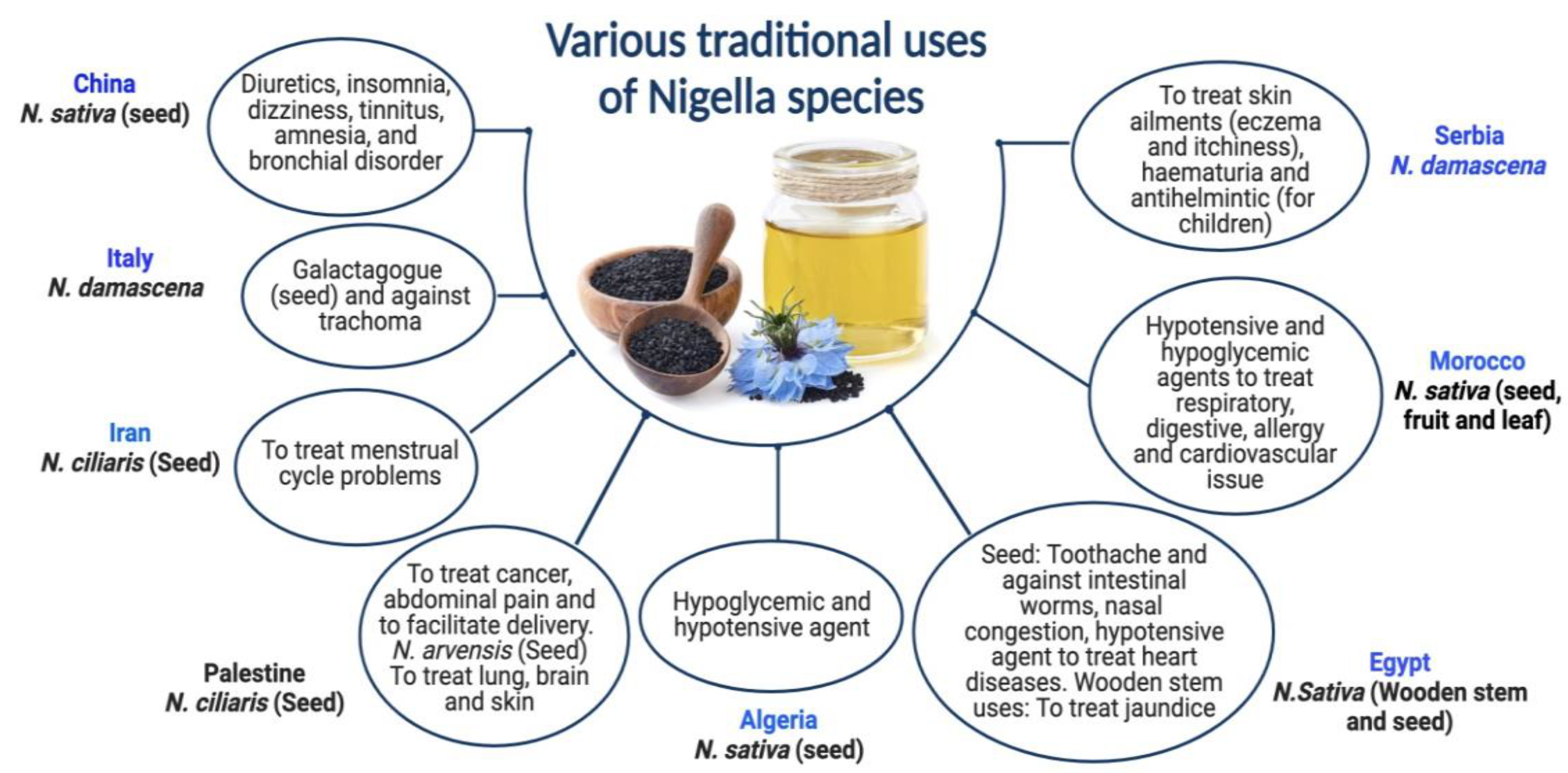
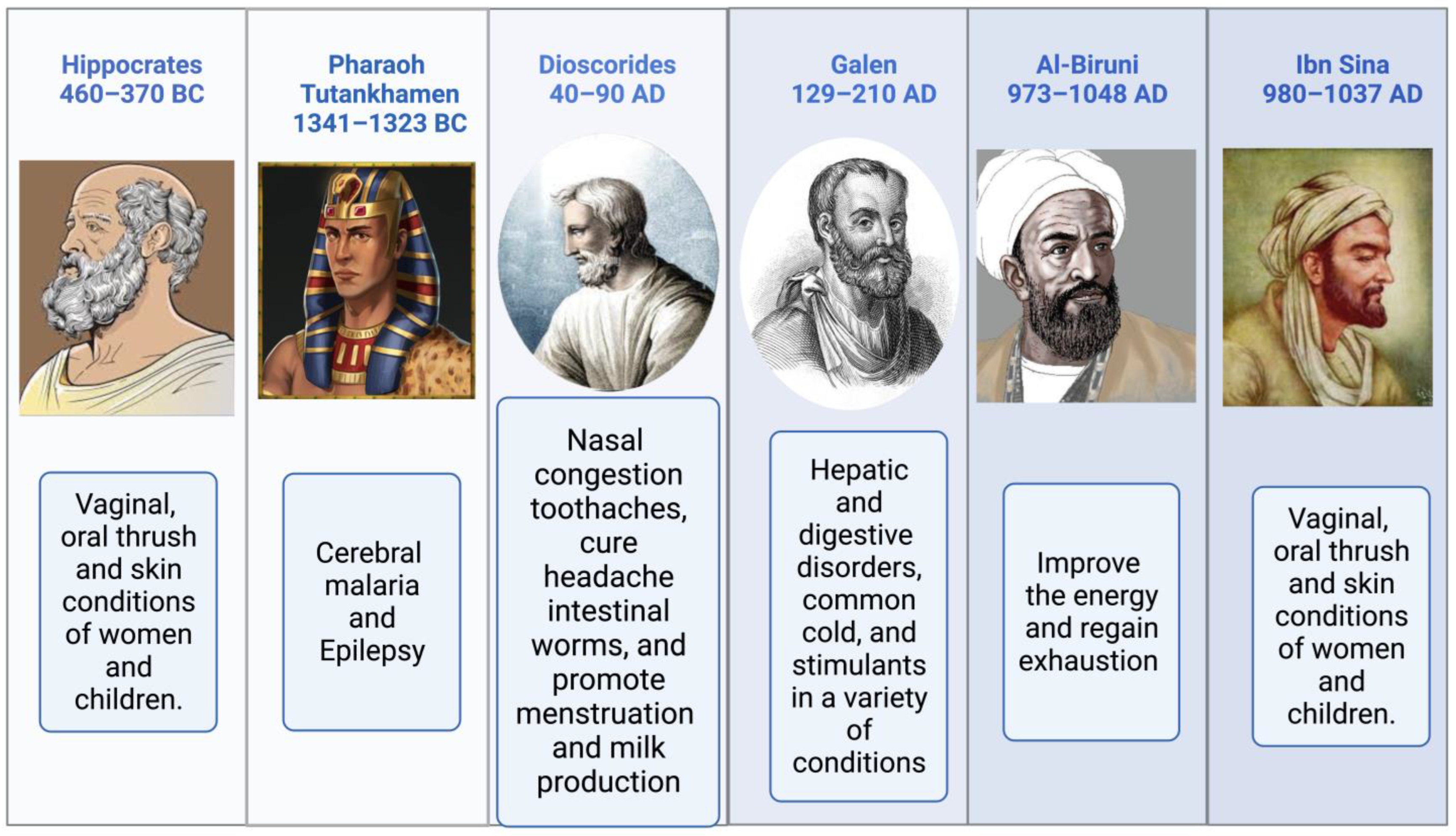
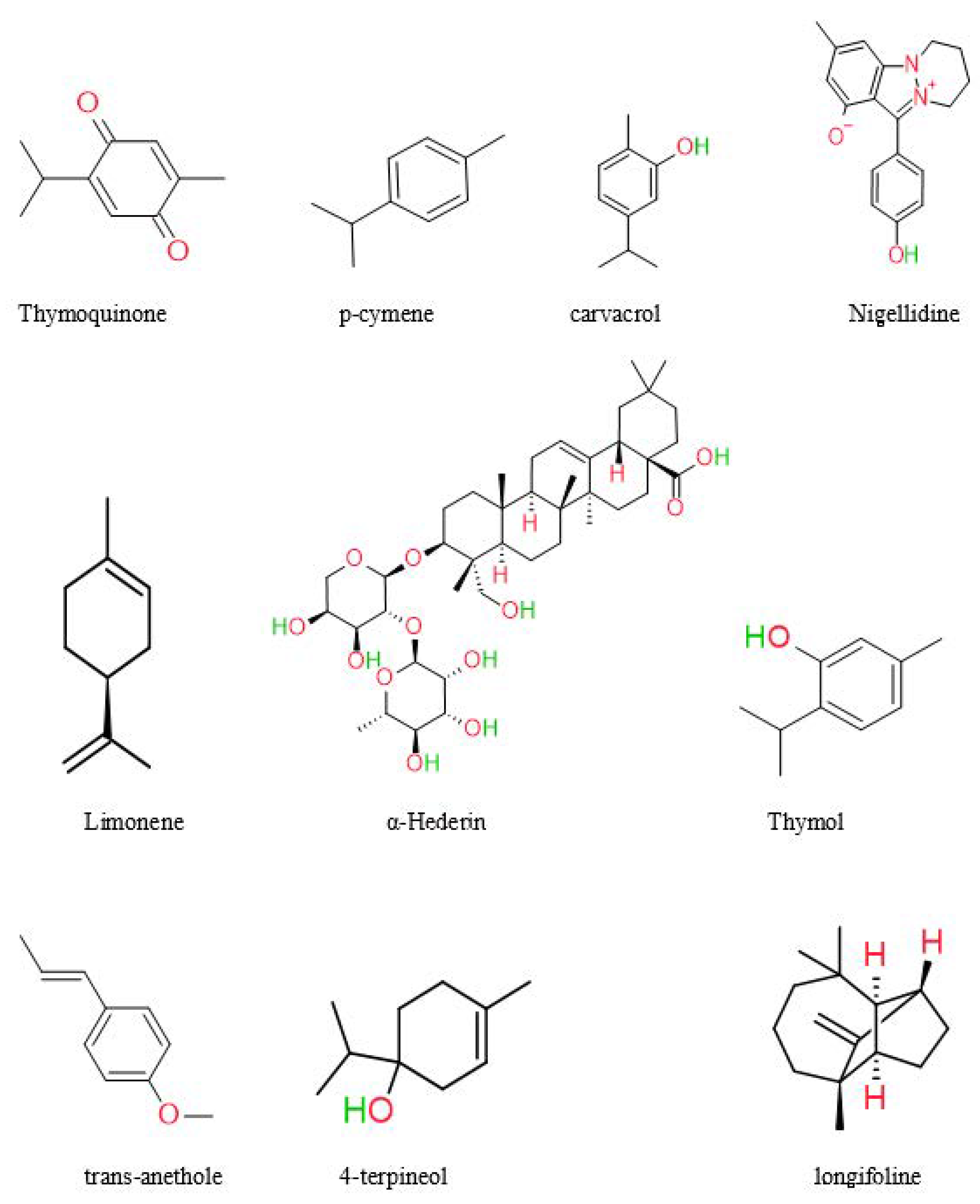
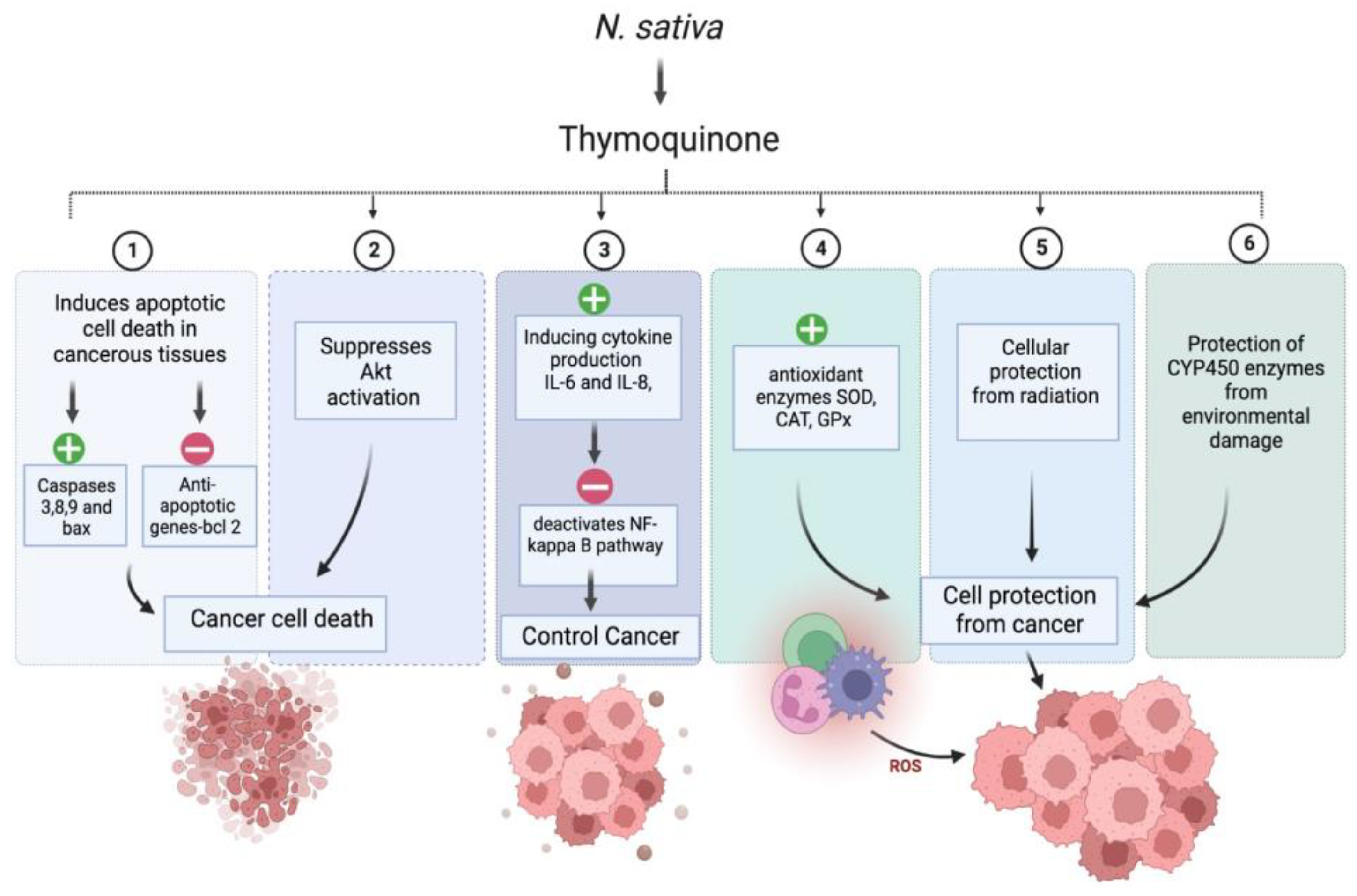
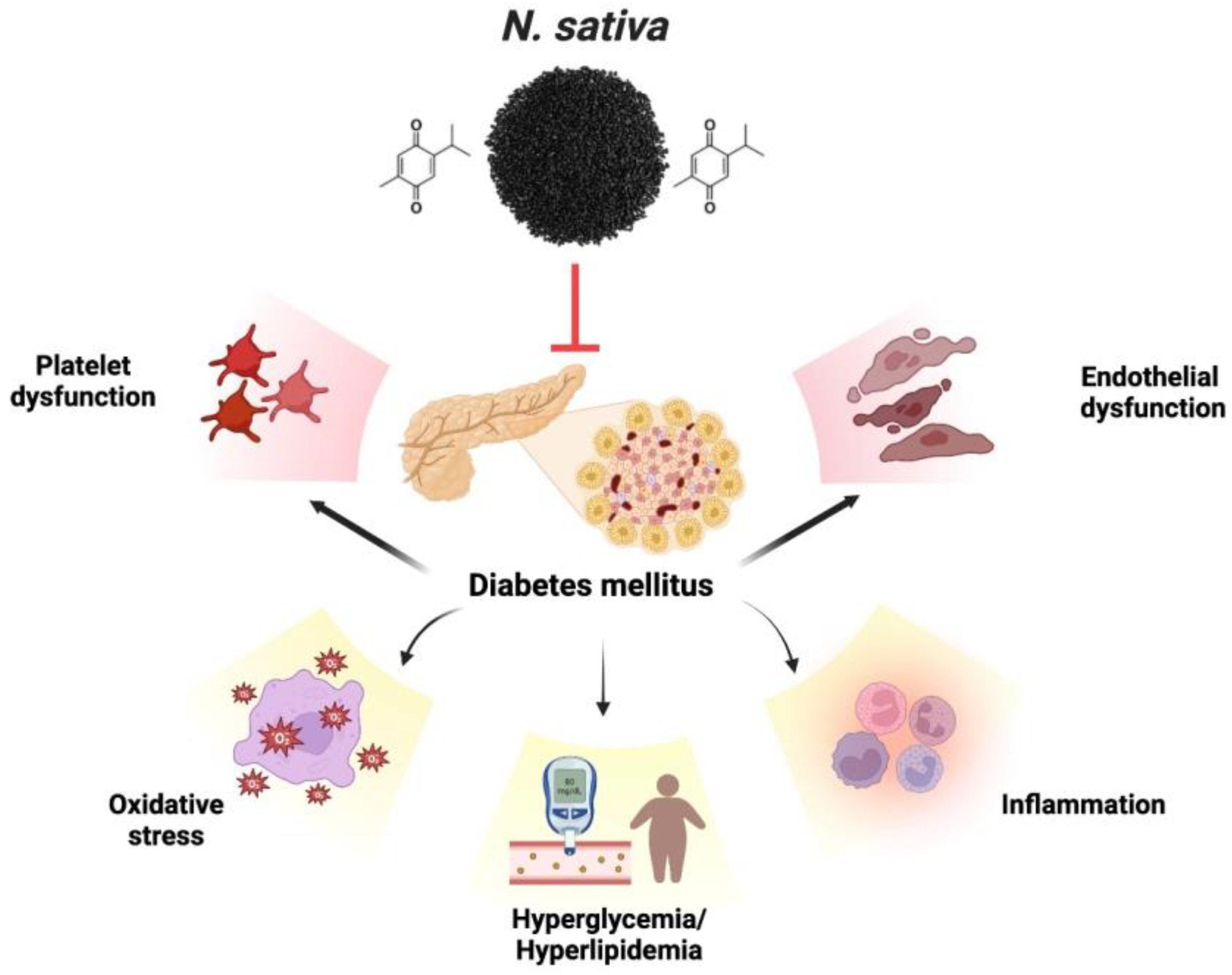
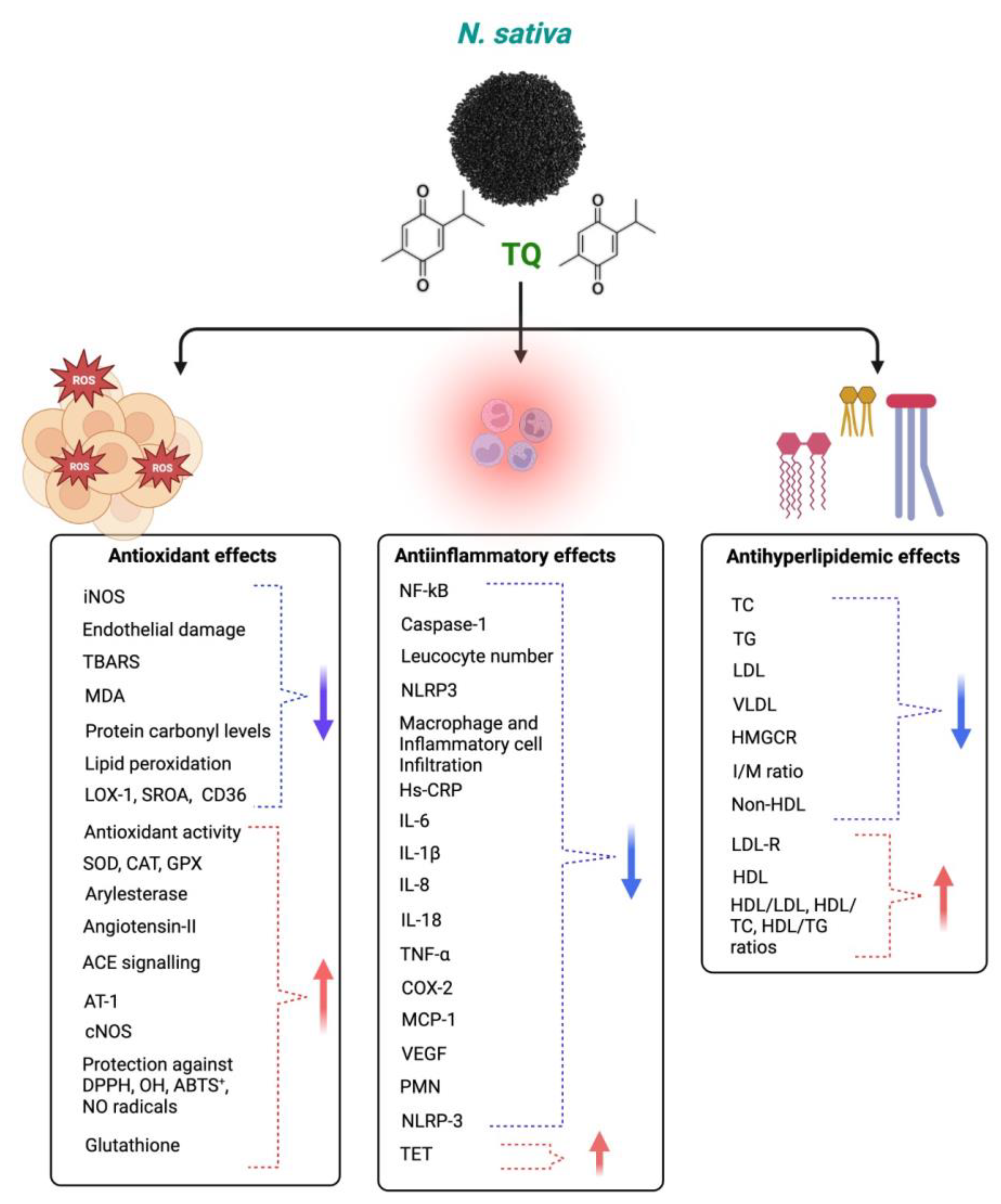
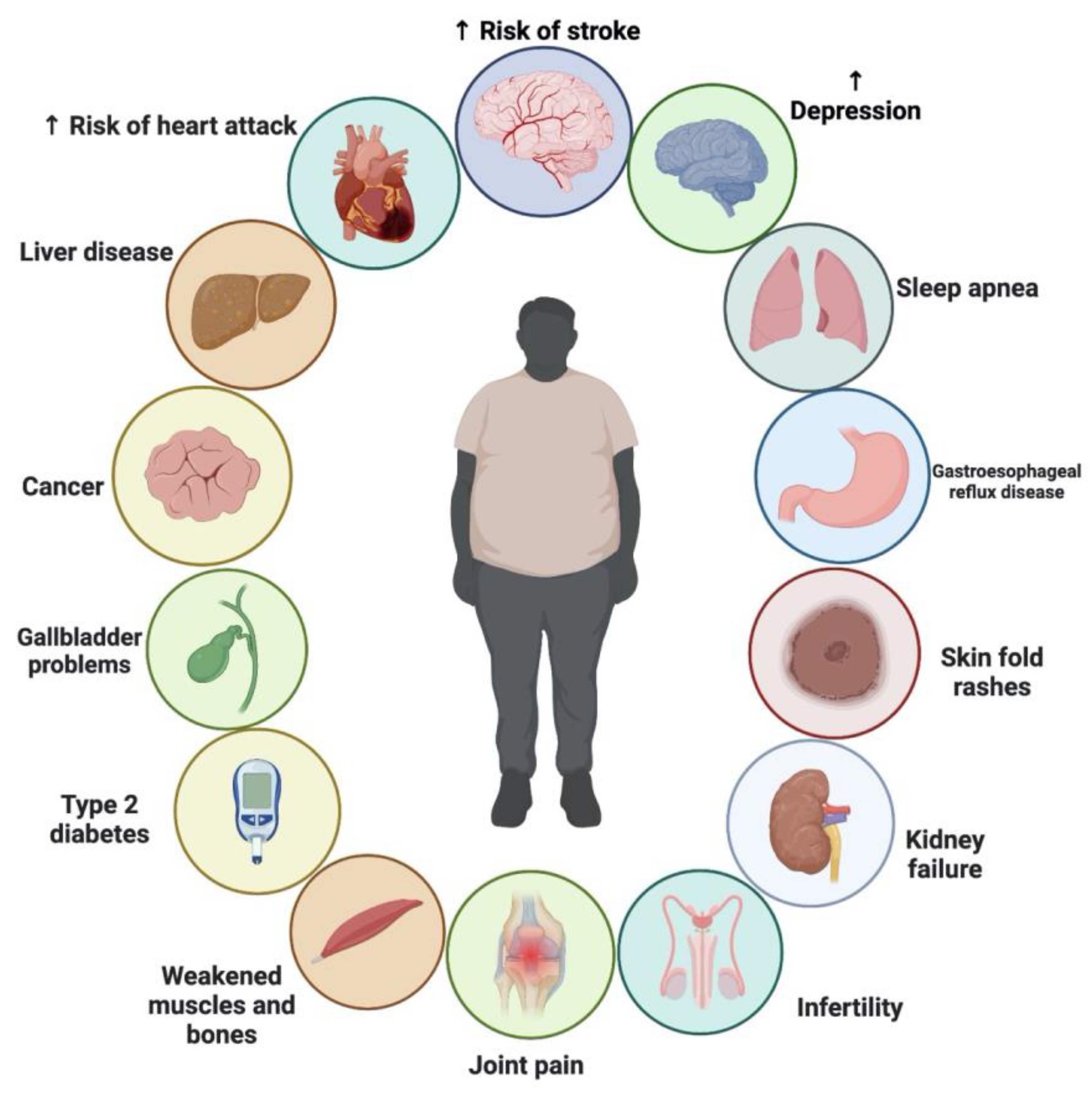
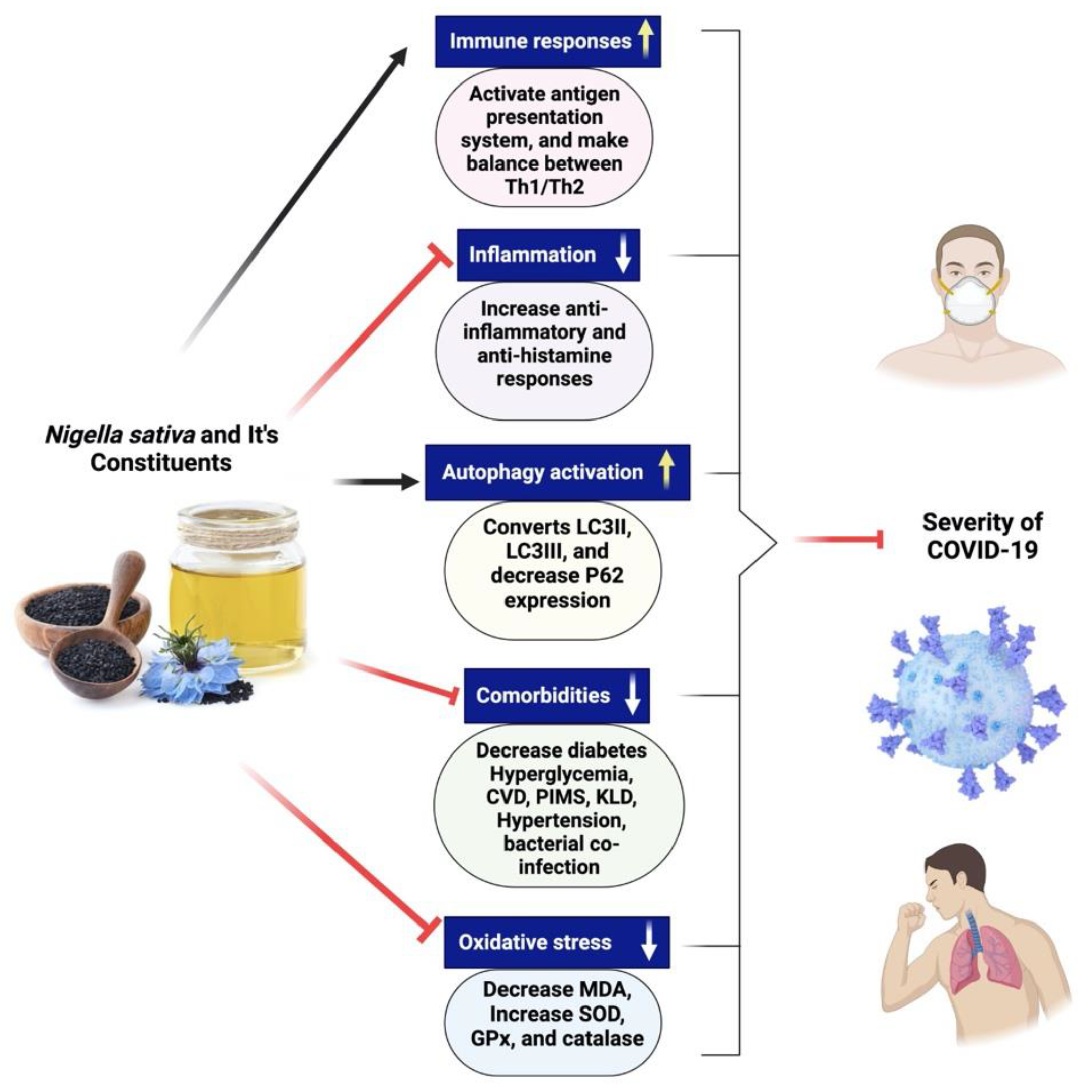
| Participants | Interventions | Comparisons | Outcomes | Study Design | References |
|---|---|---|---|---|---|
| Fifty type 2 diabetes patients | Two capsules of 1000 mg N. sativa oil were given daily to the intervention group for eight weeks. | Randomly assigned to intervention and placebo | NS oil supplements see improvements in their lipid profiles and glycemia. | RCT | [200] |
| Seventy healthy subjects | 2.5 mL Black seed oil, two times a day. | NS oil vs. placebo (mineral oil) | Significant decrease in HbA1c levels and fasting blood glucose. | RCT | [201] |
| Forty-four patients with NAFLD | Once a day, 1 g of NS oil orally for 8 weeks. | NS oil vs. placebo (paraffin oil) | Supplementing with NS seed oil improved lipid profiles and reduced FBS. | RCT | [202] |
| Thirty-nine patients with obese and overweight healthy women | 2000 mg/day of NS oil for eight weeks | NS oil vs. placebo | Reductions in CVD risk factors | RCT | [203] |
| Fifty-five with hypertension | 2.5 mL/day of NS oil for eight weeks | NS oil vs. placebo | Positive effects on glucose control and lipid metabolism | RCT | [204] |
| Fifty patients with NAFLD. | 2 g NS plus lifestyle modification | NS or placebo | Improve insulin resistance | RCT | [205] |
| One hundred and twenty-three | Kalonji seed in capsules form | Kalonji seed vs. placebo | Positive effects on FBS, serum lipids. | RA/DB/parallel | [207] |
| 90 obese women | 3 g (1 g before each meal) of NS oil daily | NS oil vs. placebo | Weight and waist circumference decreased significantly. | RA/DB/parallel | [209] |
| 50 obese women | a low-calorie diet with 3 g/day NS oil | NS oil vs. placebo | Weight loss and elevated superoxidase dismutase (SOD) levels. | RA/DB/parallel | [210] |
| Forty-five healthy women with obesity | 2000 mg of NS oil with supplement | NS oil vs. placebo | Good effects of NS supplements in treating obesity. | RA/DB/crossover design | [212] |
| 80 asthmatics patients | NS oil capsules 500 mg twice daily for 4 weeks | NS oil vs. placebo | NS oil supplementation, asthma control and pulmonary function improvement. | RA/DB/placebo-controlled trial | [190] |
Disclaimer/Publisher’s Note: The statements, opinions and data contained in all publications are solely those of the individual author(s) and contributor(s) and not of MDPI and/or the editor(s). MDPI and/or the editor(s) disclaim responsibility for any injury to people or property resulting from any ideas, methods, instructions or products referred to in the content. |
© 2023 by the authors. Licensee MDPI, Basel, Switzerland. This article is an open access article distributed under the terms and conditions of the Creative Commons Attribution (CC BY) license (https://creativecommons.org/licenses/by/4.0/).
Share and Cite
Wahab, S.; Alsayari, A. Potential Pharmacological Applications of Nigella Seeds with a Focus on Nigella sativa and Its Constituents against Chronic Inflammatory Diseases: Progress and Future Opportunities. Plants 2023, 12, 3829. https://doi.org/10.3390/plants12223829
Wahab S, Alsayari A. Potential Pharmacological Applications of Nigella Seeds with a Focus on Nigella sativa and Its Constituents against Chronic Inflammatory Diseases: Progress and Future Opportunities. Plants. 2023; 12(22):3829. https://doi.org/10.3390/plants12223829
Chicago/Turabian StyleWahab, Shadma, and Abdulrhman Alsayari. 2023. "Potential Pharmacological Applications of Nigella Seeds with a Focus on Nigella sativa and Its Constituents against Chronic Inflammatory Diseases: Progress and Future Opportunities" Plants 12, no. 22: 3829. https://doi.org/10.3390/plants12223829
APA StyleWahab, S., & Alsayari, A. (2023). Potential Pharmacological Applications of Nigella Seeds with a Focus on Nigella sativa and Its Constituents against Chronic Inflammatory Diseases: Progress and Future Opportunities. Plants, 12(22), 3829. https://doi.org/10.3390/plants12223829




